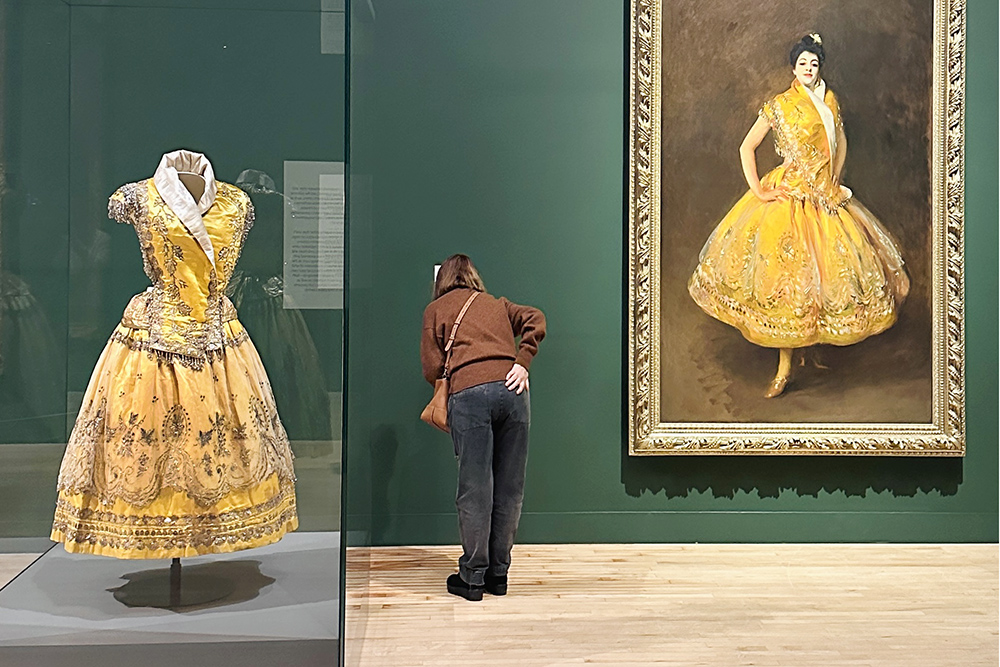
Thursday was a day of art & indulgence.
Walking through Chelsea, I kicked off the adventure at Birley Bakery with a delectable almond croissant, crispy golden-brown pastry, toasty warm out the oven and the sweet almond paste within.
Baked goods in hand, I was on the search for John Singer Sargent’s former home and studio.
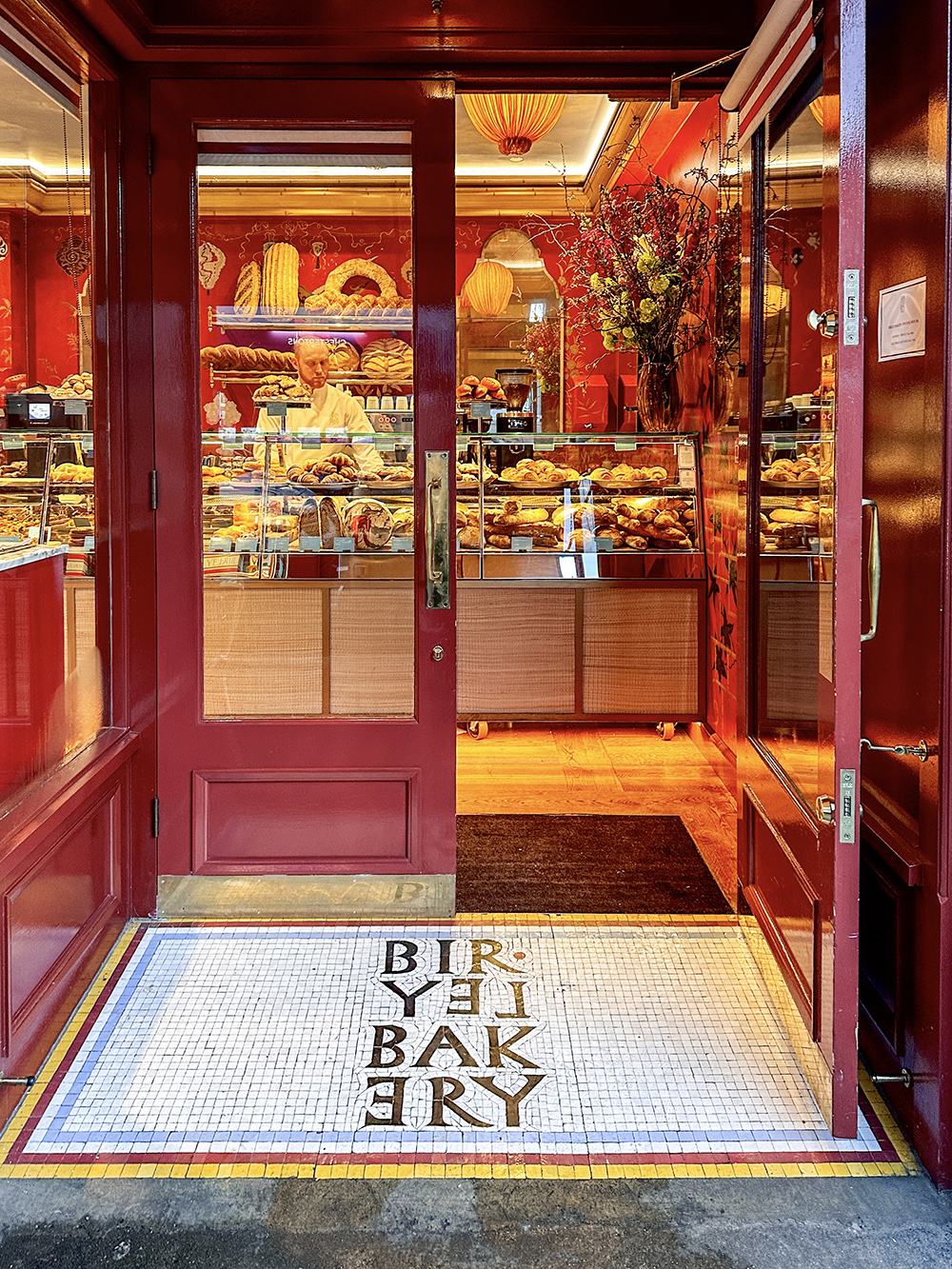
Outside Birley Bakery in Chelsea.
Sargent (1856–1925) is known for his fabulous brushwork.
He painted portraits of society families, powerful art collectors or theatrical performers draped in satin, lace and rich velvets. He contrasted bolder, impressionist brushstrokes on the fabrics with a lightness of touch on the features.
Born in Florence in 1856 to American parents, he lived in several European countries as a child before shaping his artistic reputation in Paris. (You can see a portrait of his tutor in the article: Singer Sargent & Friends)
In 1886, Sargent settled in London at the centre of society with an accomplished circle of friends that included Henry James, Claude Monet and James Abbott McNeil Whistler.
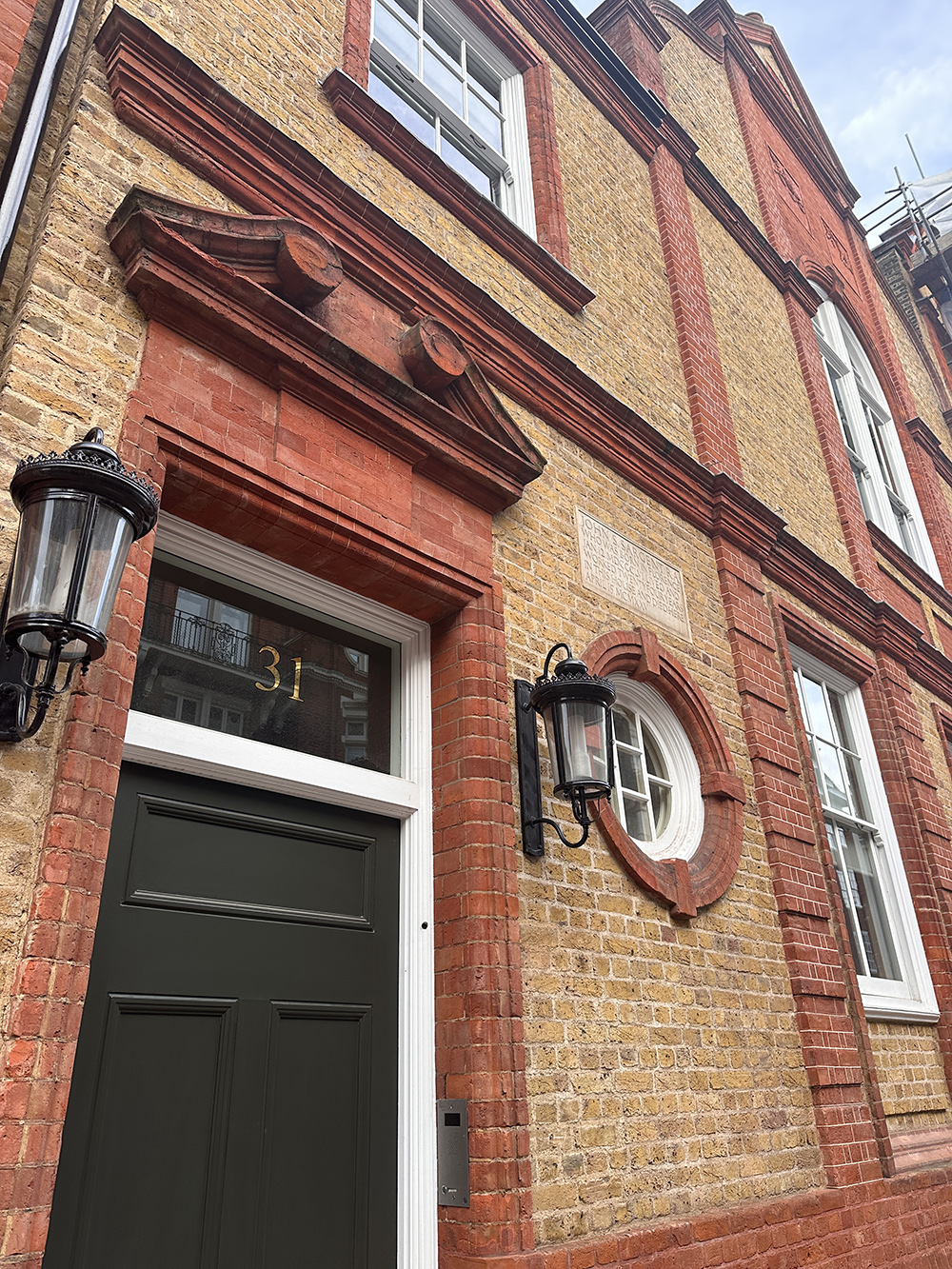
Outside 31 Tite Street, Chelsea, London
His studio sits on 31-33 Tite St, and you can see the huge studio window above, it was actually in the same building as Whistler’s original studio. The buildings are unbelievable.
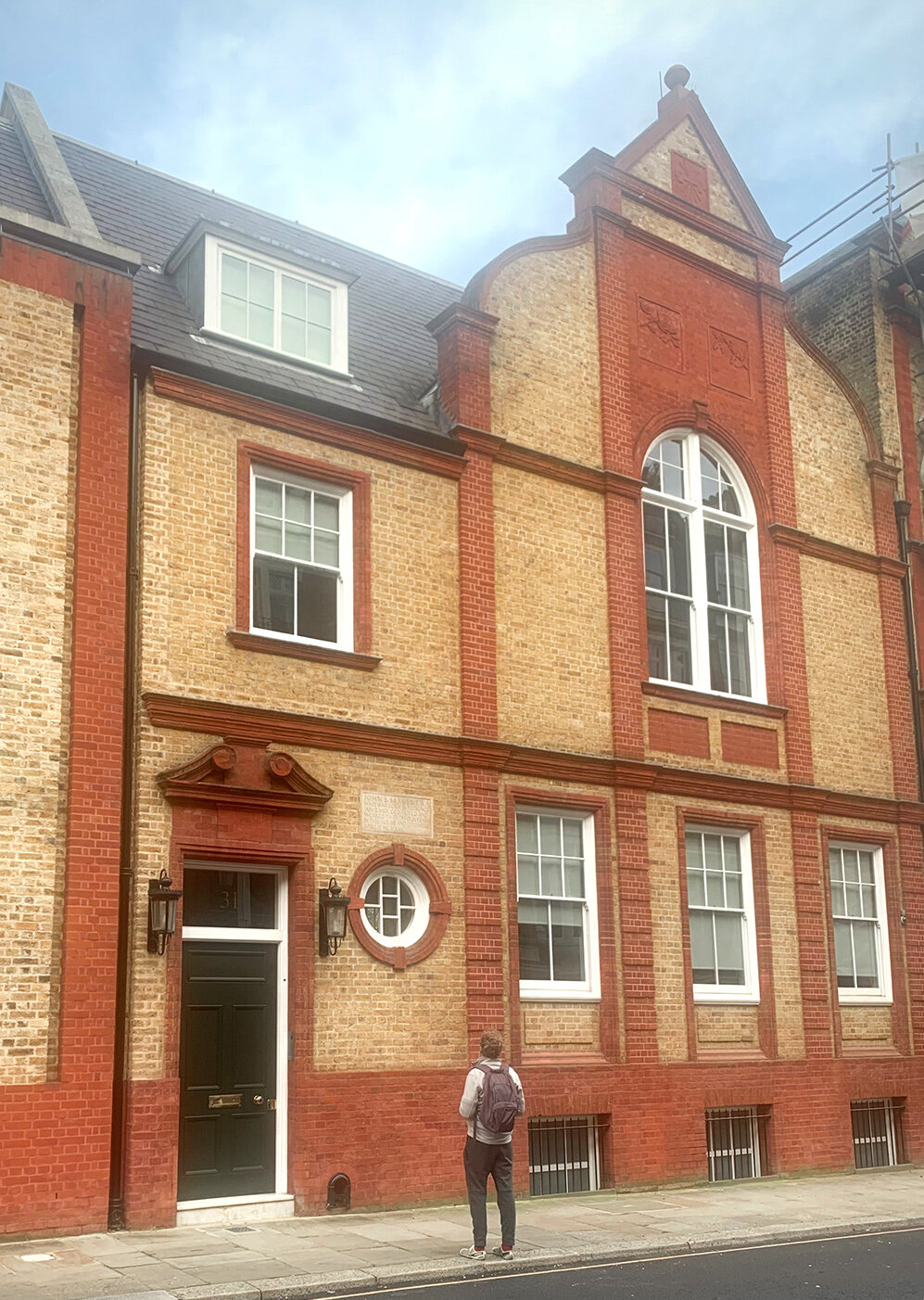
In 1900, Sargent expanded into number 31 cutting a hole in the wall between properties, using 31 as his home and keeping 33 as his studio. It would remain his home for the rest of his life.
“[The] windows face north and south, twenty feet of sheer light, with muslin soothing or baffling the light over the street-side window. It is not possible to be in this room and not feel better.
Candia McWilliam, Author and later resident of 33 Tite Street
I took 10 minutes to soak it all in and did a wobbly fountain pen sketch standing in the drizzle.
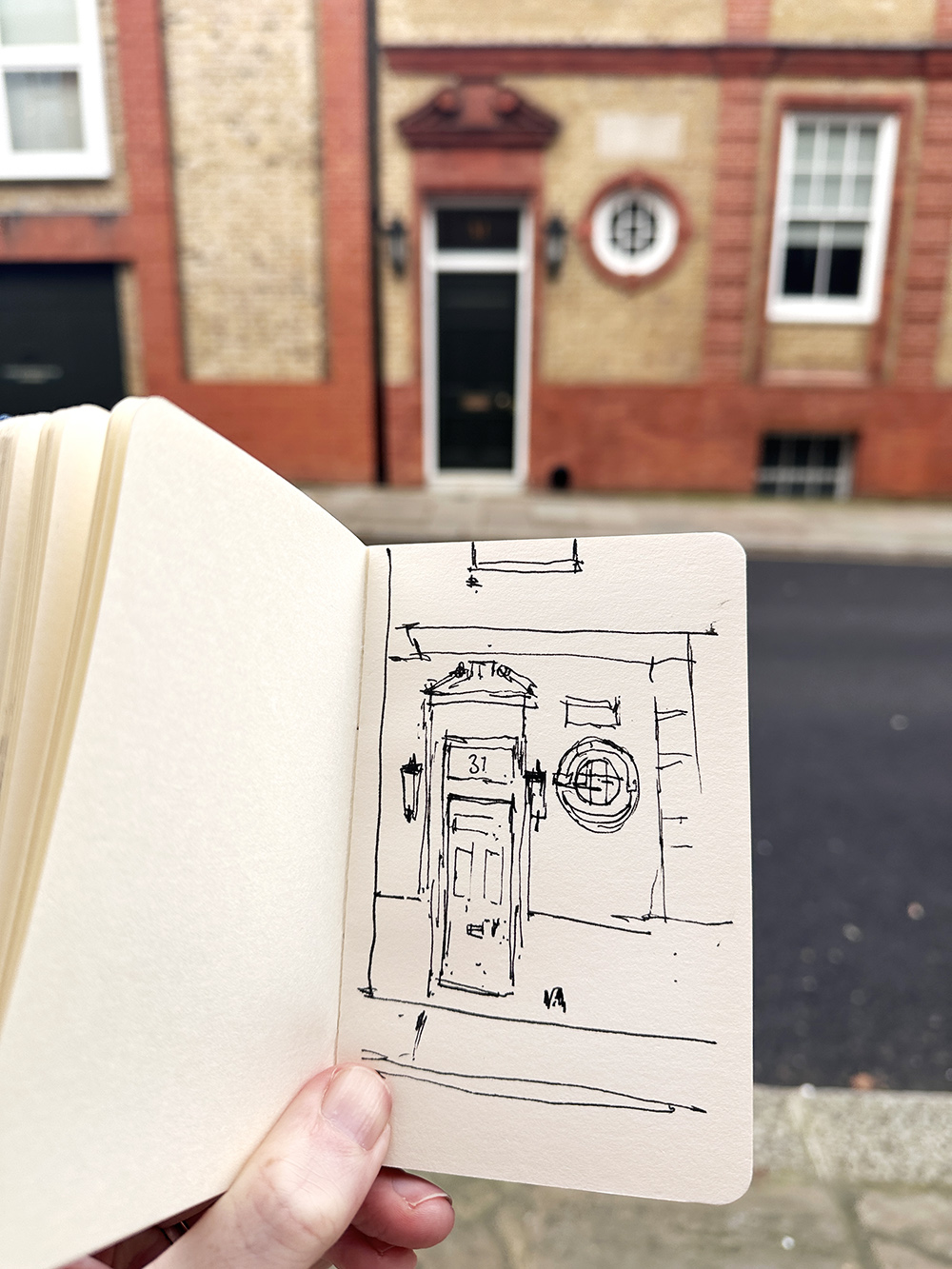
Tite Street is situated within the Royal Borough of Kensington and Chelsea, just north of the River Thames, London, with peaceful, leafy streets. In the late 19th century, the neighbourhood was a fashionable location for people of an artistic and literary world, and its history of residents is dazzling!
Anna Lea Merritt, artist; Augustus John artist, Paul Edward Dehn, screenwriter for some of the Bond films, interestingly Fleming placed James Bond home only a few streets away; Peter Warlock, composer; Mick Jagger, Oscar Wilde, Turner and Whistler to name only a few, so just the walk down the street reading the blue plaques is exciting.
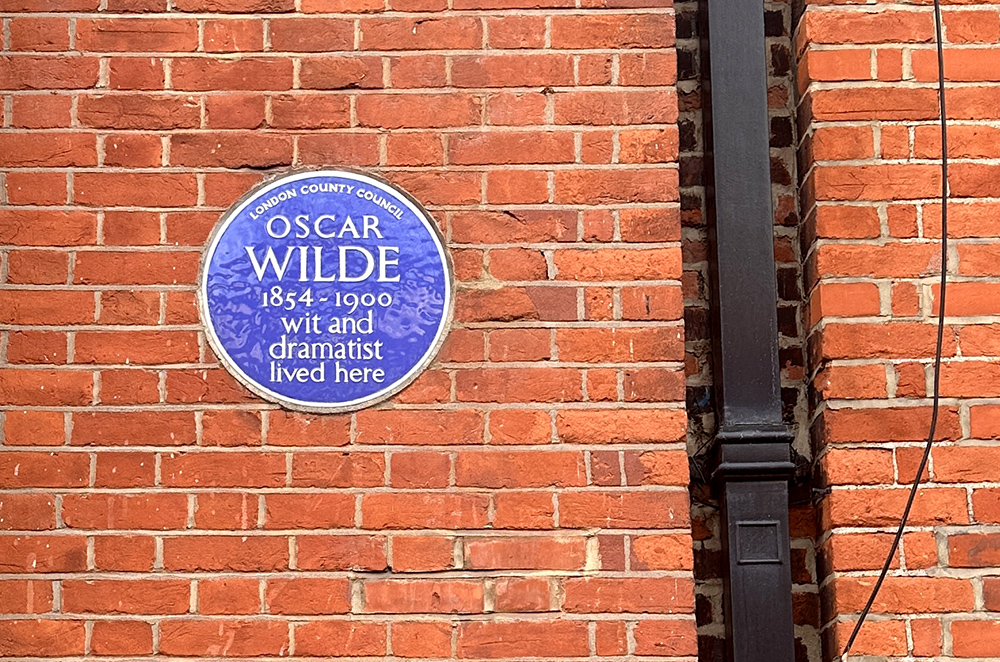
Pro tip: You can see an interactive map of the blue plaques in London here: Blue Plaque Map London
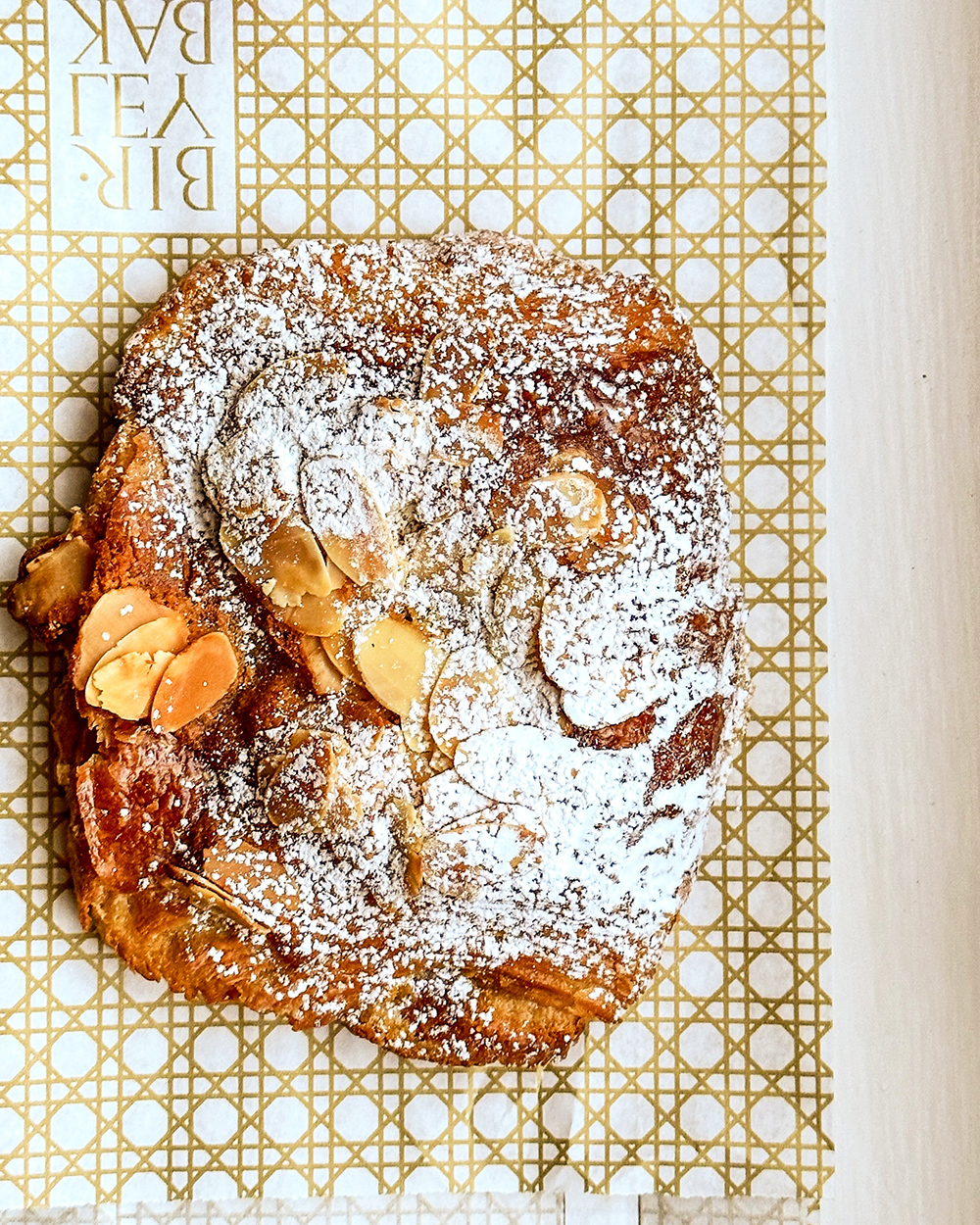
I also took a chocolate and almond croissant for an afternoon snack on the way to Tate Britain and excitedly carried on to the second part of my journey.
Sargent and Fashion
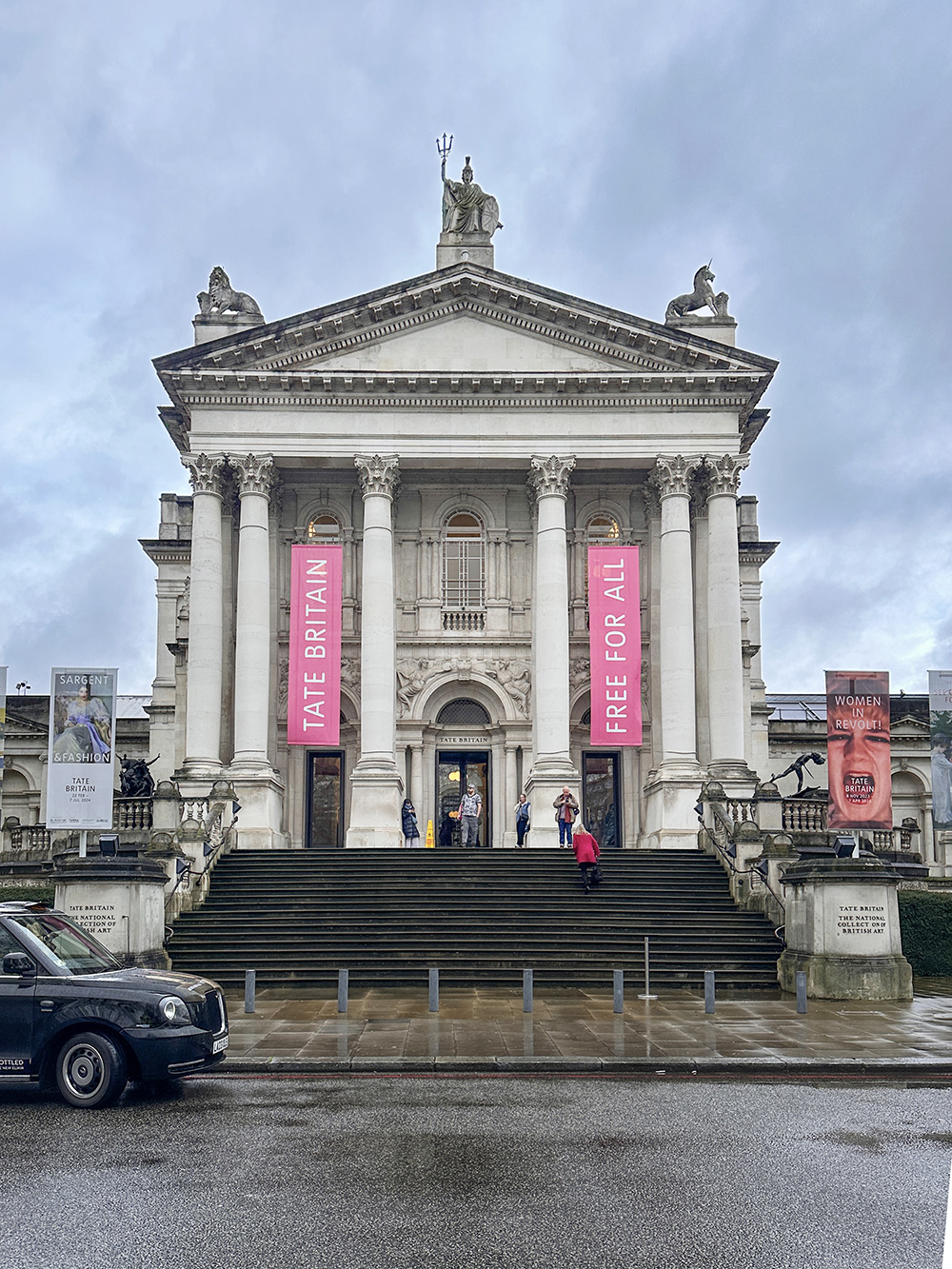
From 22 February 2024 until 7 July 2024, Tate Britain, London, is showing over sixty paintings by John Singer Sargent, including major portraits rarely seen in the U.K. Several items of period clothing are also shown alongside the portraits in which they were worn.
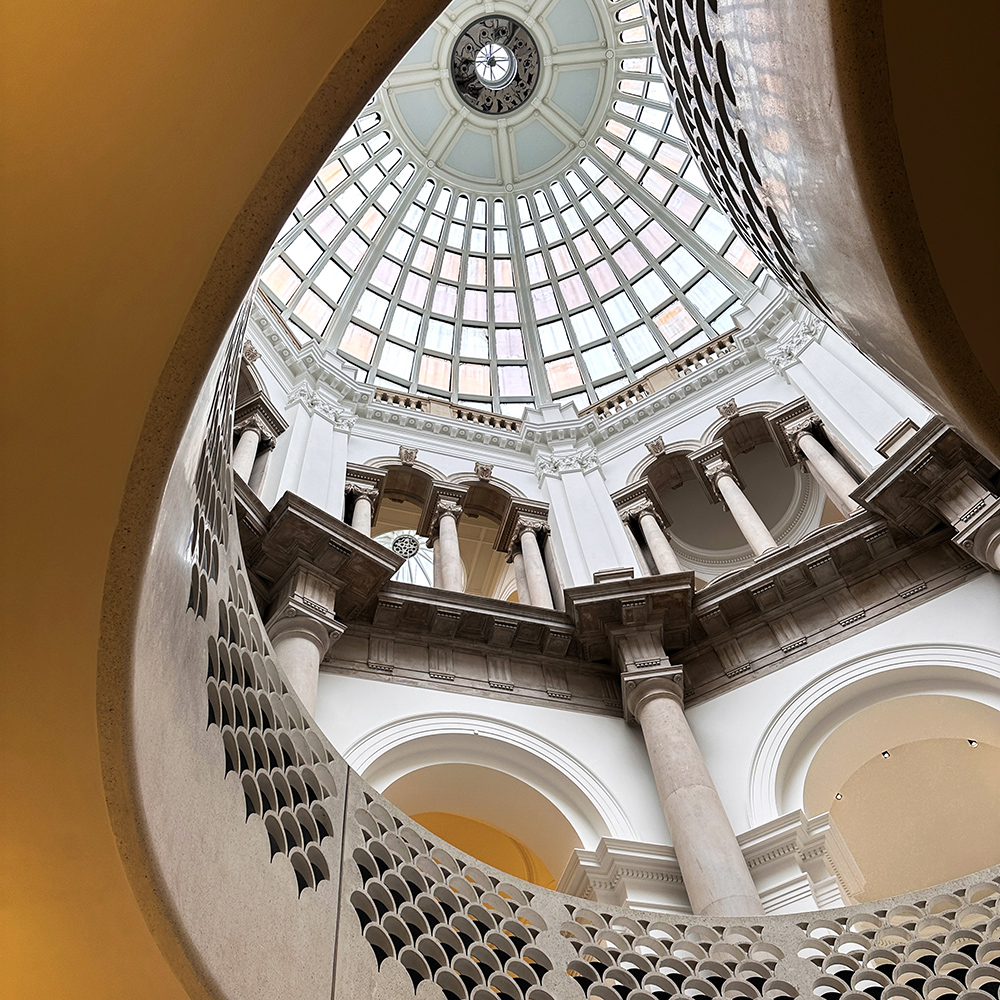
Sargent used fashion to express identity and personality. He regularly helped choose the outfits or costumes of his sitters, and the manipulation of the fabrics became central to his painting. He pinned, draped and tucked his sitter’s clothes to create new shapes and textures, rearranging a heavy coat tighter or allowing a silk gown to fall in pools of light.
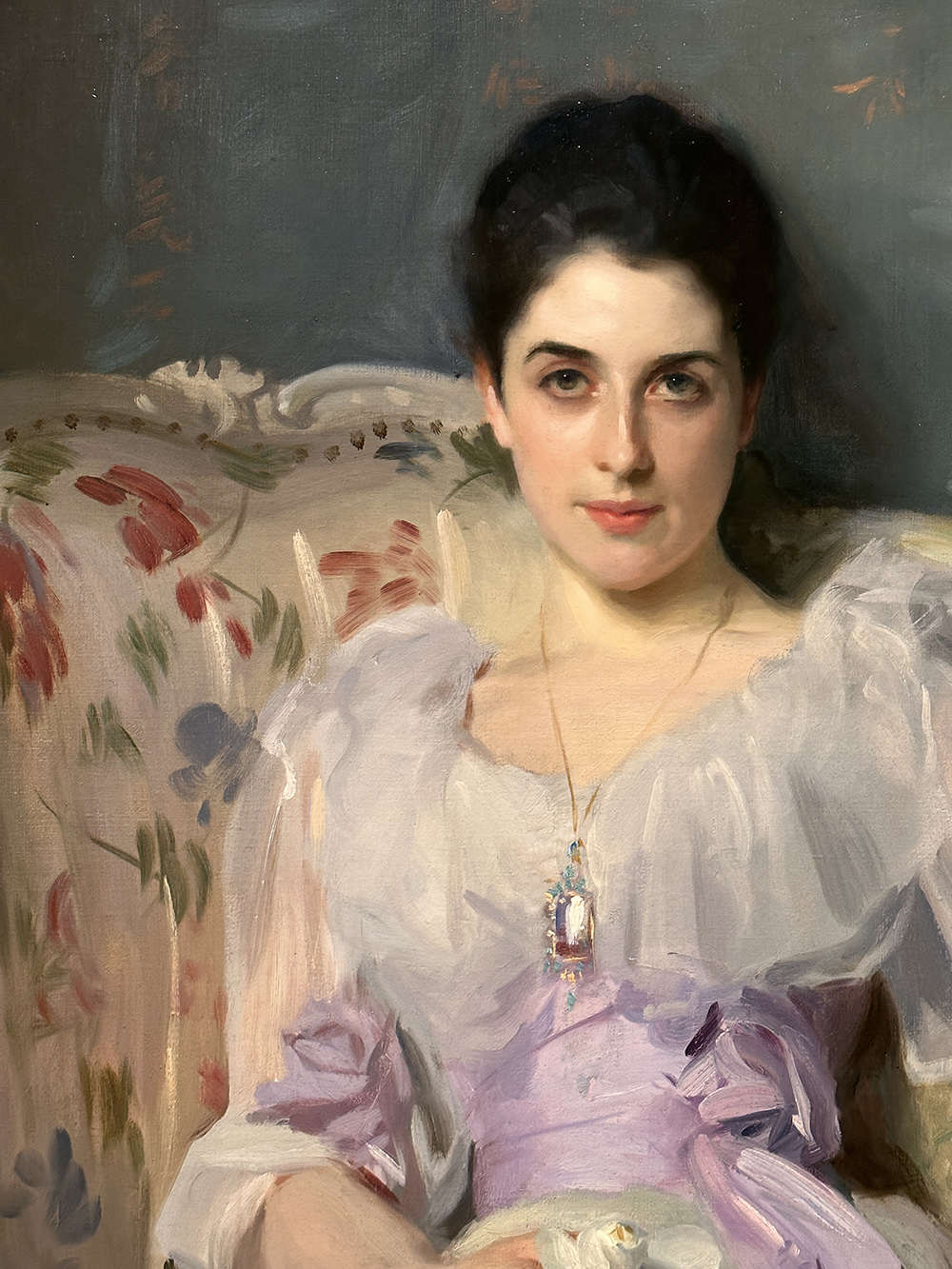
Lady Agnew of Lochnaw, John Singer Sargent, Oil on Canvas, Detail, 1892
Sargent and his sitters thought carefully about the clothes he would paint them in, the messages they would send and how well particular outfits would translate to paint. One French critic noted at the time, ‘There is now a class who dresses after pictures, and when they buy a gown, they ask if it will paint?’
Initially, I was intrigued to see if these items of clothing and accessories were needed, would they crowd or detract from the already compelling paintings?
But in reality, they were very helpful as a teaching tool for understanding Sargent’s approach to painting. One of the hardest things when learning to paint is to learn what to leave in and what to leave out while still capturing the essence of the subject you’re looking at.
When you are studying Sargent’s work up close, it looks like a selection of random abstract marks. Only the subject is revealed when you step back from the canvas.
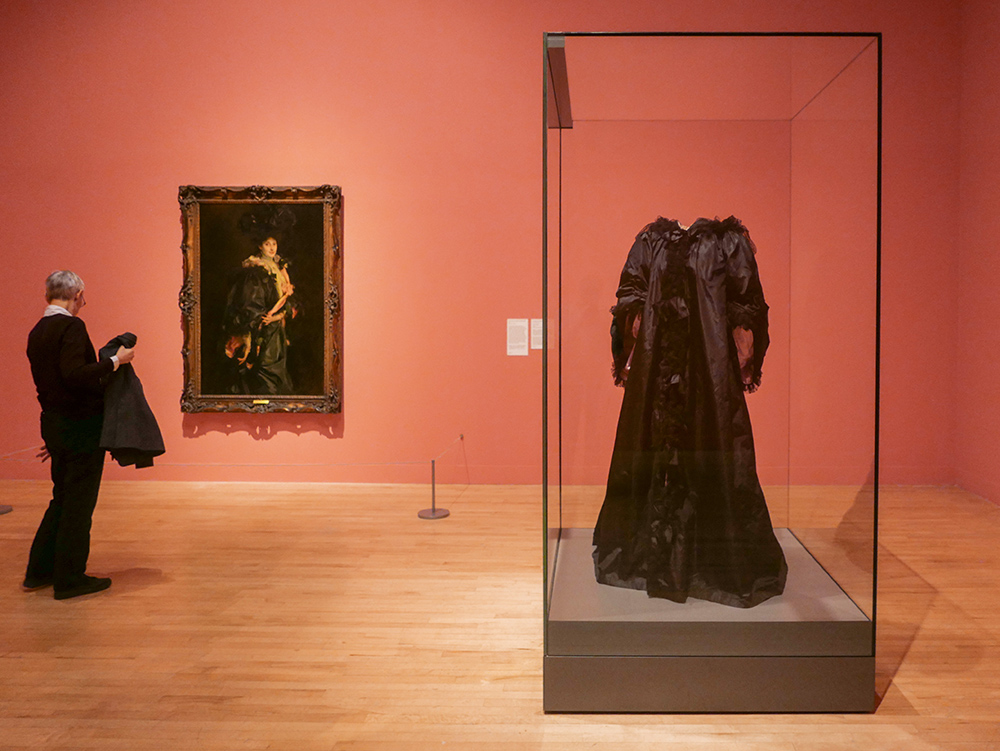
To the right of the painting is the original coat featured in the portrait
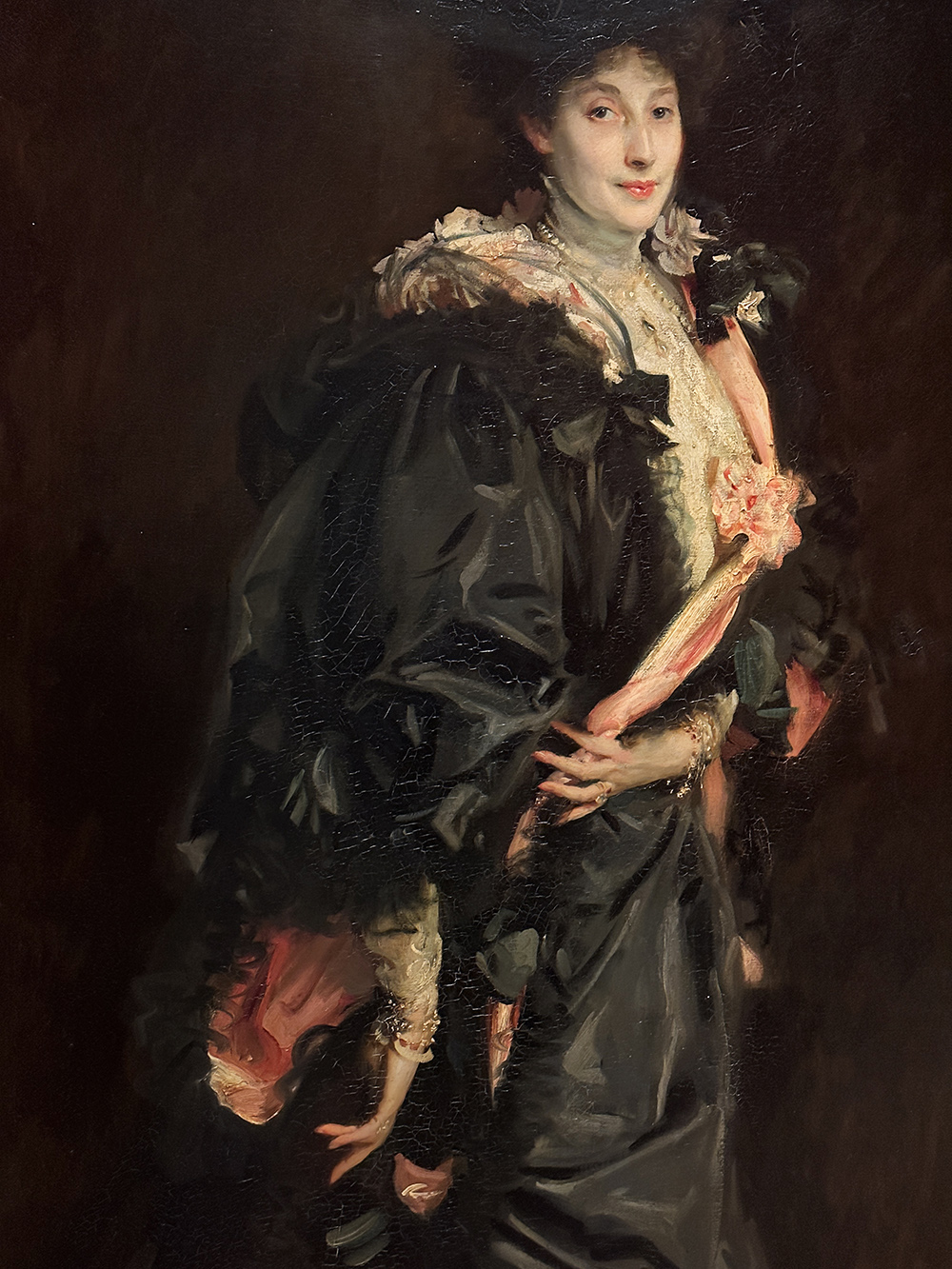
Lady Sassoon, John Singer Sargent, Oil on Canvas, 1907
In this portrait, Sargent posed Lady Sassoon wearing a taffeta cloak. Taffeta is a thin fabric often made from silk that shifts with the light and luxuriously falls to the floor in big folds.
Pink roses, a string of pearls, bangles on both wrists and an amazing hat of black ostrich feathers completed her outfit. Lady Sassoon was a talented artist herself, working in pastels. Raised in Paris, highly educated, and a music lover, they became good friends.
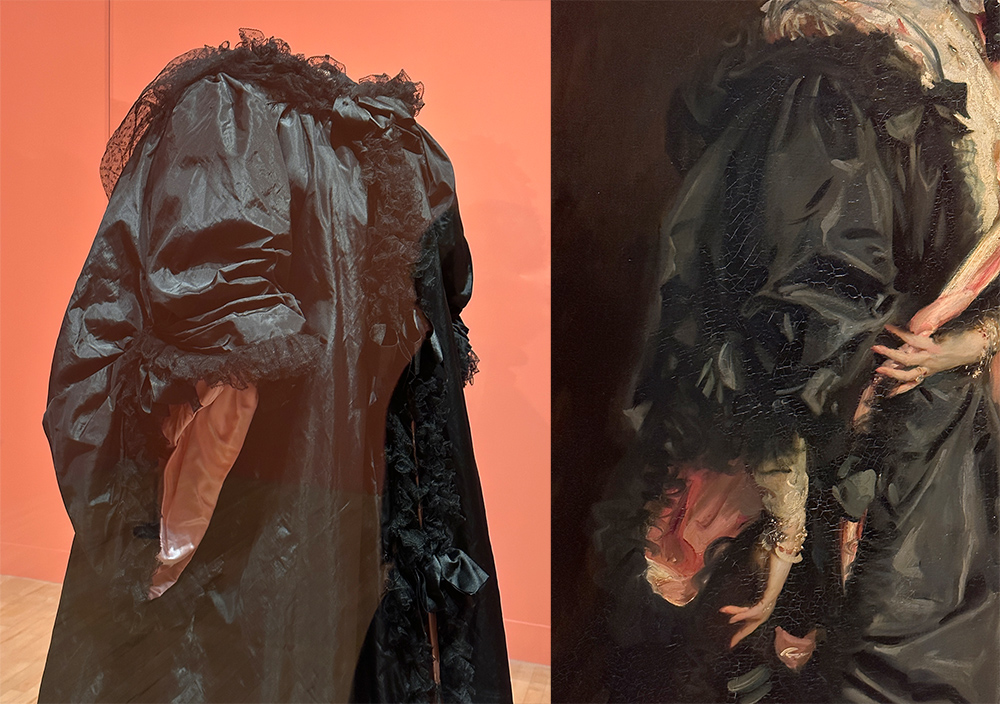
The fabric holds its shapes in concave pools that reveal the lightfall
You can see how Sargent shaped the dark cloak, wrapping it around her to get exactly the right play of light on the fabric. And because you’ve just got a black-on-black subject, Sargent needed something to break up the view, so he uses the inner pink lining of the cloak to direct our eyes.
It’s barely noticeable in real life, but it has been wrapped or rolled back to add a streak of colour that guides our view across the portrait’s surface. The diagonal adds movement; we see one hand, then our eyes travel down to the other hand, then curve back to us.
What I thought was interesting was that the cloak, in reality, has a muted pink lining, but in the painting, Sargent has increased the saturation. This stronger saturation is mirrored on the right-hand side of the painting. He’s pushed the colour to control our gaze.
When you study the hands, the upper one is quite detailed, but compared to the lower one, you can see how he’s used more refined brush strokes and lost all the edges of the fingers.
Notice how the upper finger is a lot pinker because of the reflected light from the pink of the lining, and the texture surrounding it is very gestural and more impasto. You’ll see this a lot through all of the paintings. Thin, smooth layers underneath and gestural marks over the top.
Black dresses became very fashionable during the late 19th century, and although they kept their association with mourning, etiquette was relaxed enough to make them a much more acceptable fashion, and the introduction of synthetic, intense, pure black dyes meant a real new depth of colour not seen before.
Paint it black
Sargent really enjoyed working black on black.
He admired this technique in the work of Spanish painter Diego Velazquez and Dutch artist Frans Hals.
During the 1880s, he painted almost half his female sitters of different ages, all wearing black gowns. The colour was so integral to his work that when visiting his friend, French artist Claude Monet, Sargent couldn’t work upon learning Monet had no black paint. You can just imagine the scene!
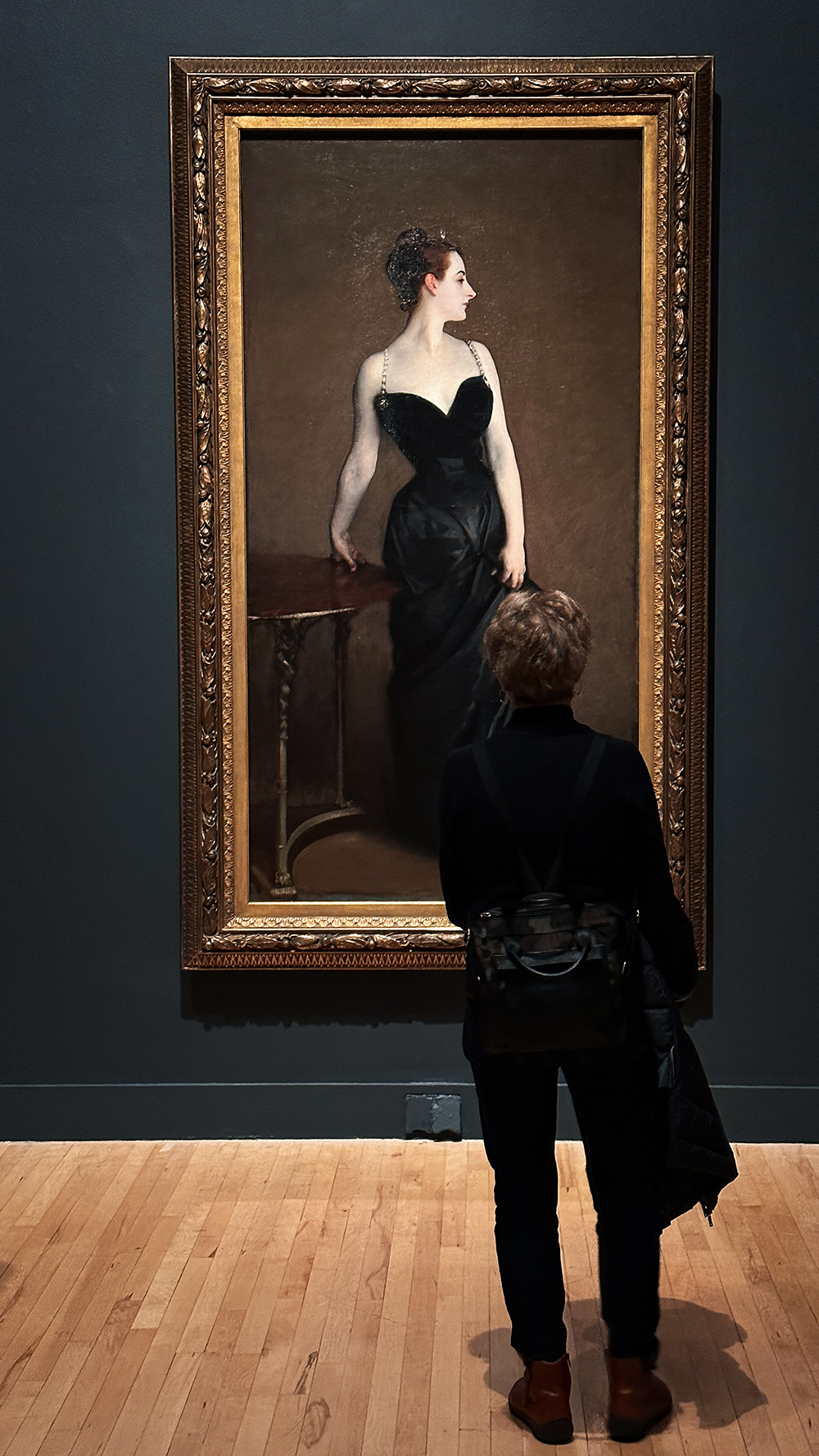
Madame X, John Singer Sargent, Oil on Canvas, 1883-4
Sargent painted Virginie Amélie Avegno Gautreau in a black satin dress with jewelled straps; the pale flesh tone, which she accentuated with pale makeup, contrasted against the dark dress and background. Gautreau was admired in Parisian social circles for her great beauty and appearance. Although she had refused numerous similar requests from artists, she accepted Sargent’s offer to paint her in February 1883.
The most striking thing in this portrait is the pale skin next to the dark and the pose.
I love how he’s weighted the pose, so you can feel the pressure of her on the table. It also reminds me of the plaster cast you paint in a Classical Atelier, almost like a statue, so upright. It’s very powerful.
If we look again at Sargent’s hands, it’s very interesting how the one-hand position is posed on the left and the other is grabbing hold of the ruffles, which creates the tension in the gown and holds the whole pose together, so it just feels extremely straight.
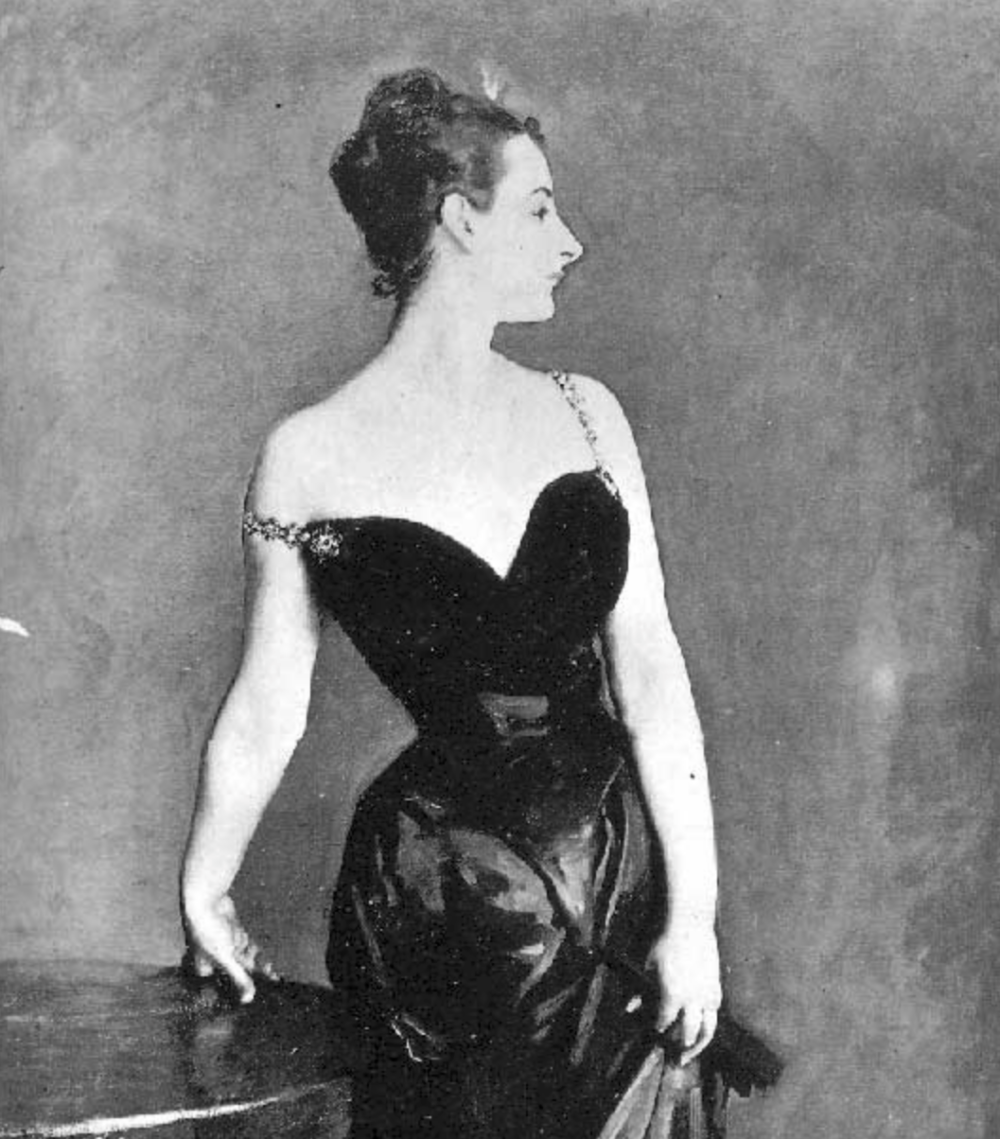
As Madame X was originally shown in The Paris Salon 1884 exhibition scandal
Sargent’s original Madame X was first exhibited at Paris Salon’s 1884 exhibition in a much more daring pose, showing one of the jewelled straps of her dress falling off her shoulder.
Sargent insisted he painted her ‘exactly as she was dressed’, and Gautreau described it as a masterpiece in a letter to her friend.
But immediate reactions to the painting were negative; it instantly became a scandal in French society, criticising the indecency of the dress.
Sargent was severely disappointed by the critics and public reaction and overpainted the shoulder strap to raise it and make it look more securely fastened. He left Paris soon after, feeling his reputation had been damaged.
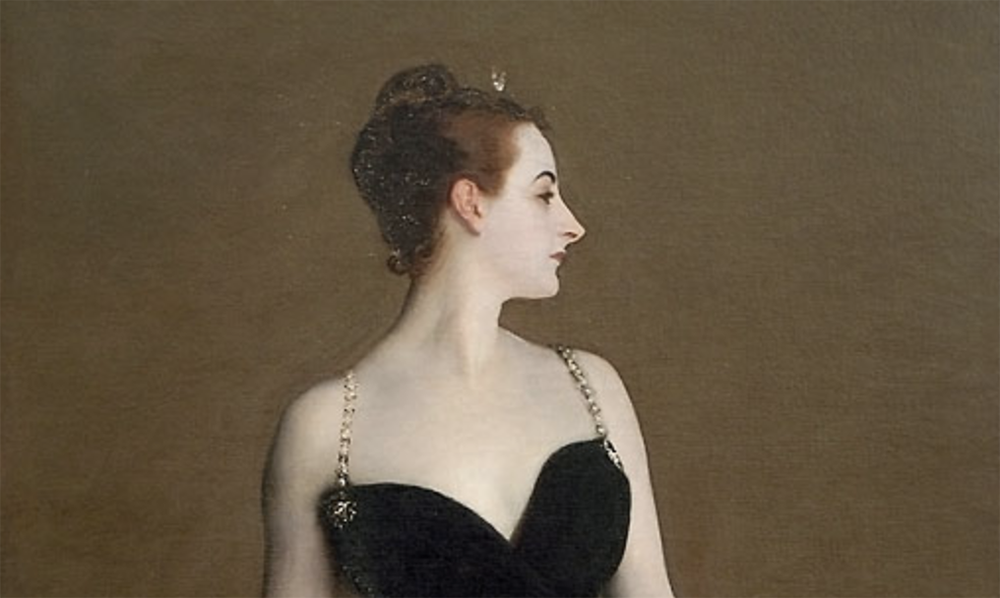
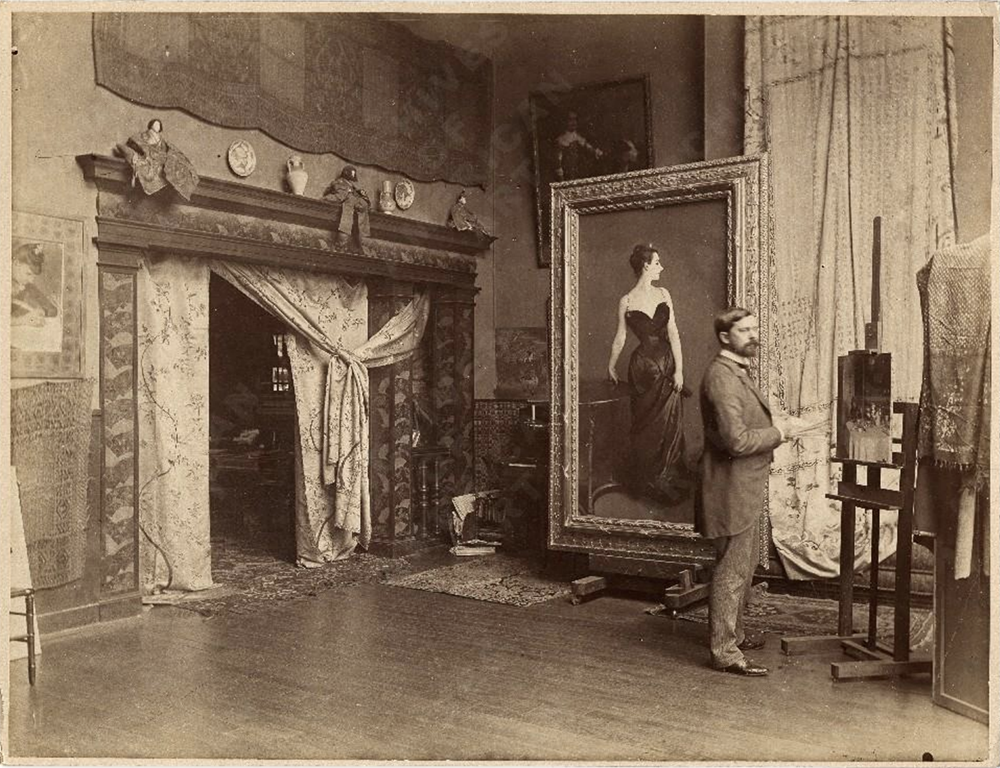
Sargent painting Madame X in his Paris Studio
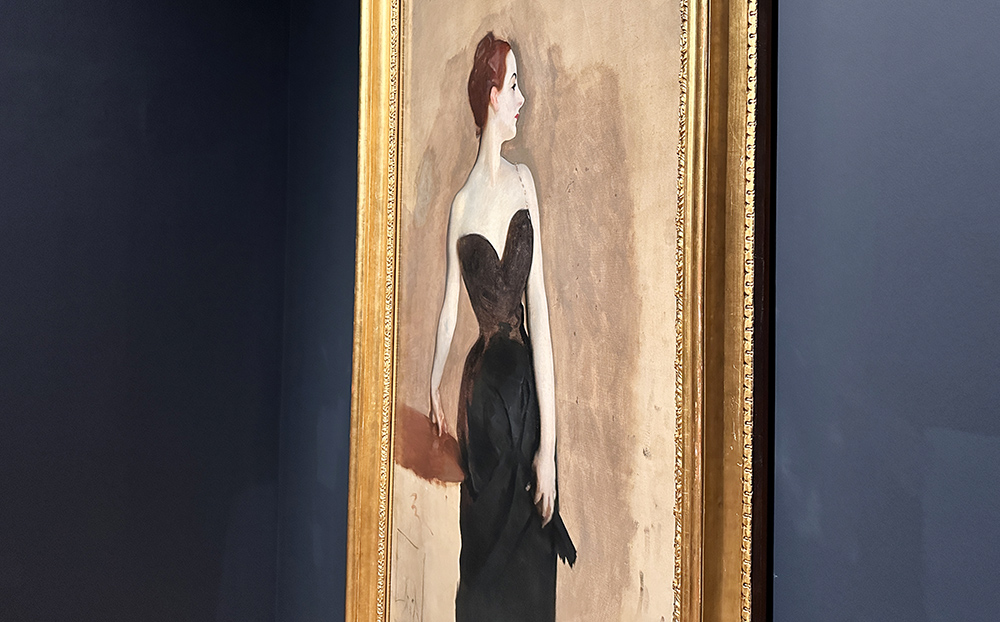
And then you see the sketch of it.
I really liked this sketch, probably because I just love unfinished paintings. They always have a bit more energy to them, you can see how they were put together. But it’s so interesting to see how the hair looks a lot redder in the sketch because you’ve got other warm elements around it. This study was probably painted before the 1884 Paris Salon. The right strap is missing, suggesting that Sargent was unsure about its position.
He kept this painting until his death.
The Price of a Portrait
Sargent’s career in Britain coincided with a revival of interest in historical portraitures such as those of Joshua Reynolds and Thomas Gainsborough.
Even though Sargent adapted a style resembling it, he painted relatively few members of the British aristocracy, his clientele was international, and many of his sitters came from finance, commerce, the arts, or the sciences. A portrait by Sargent might serve as a reassuring symbol or announce the arrival of more recently wealthy people into high society.
Compelling portraits were widely discussed and frequently reproduced, so Sargent’s work was much in demand from sitters seeking an authoritative image of themselves and an upgrade in social status.
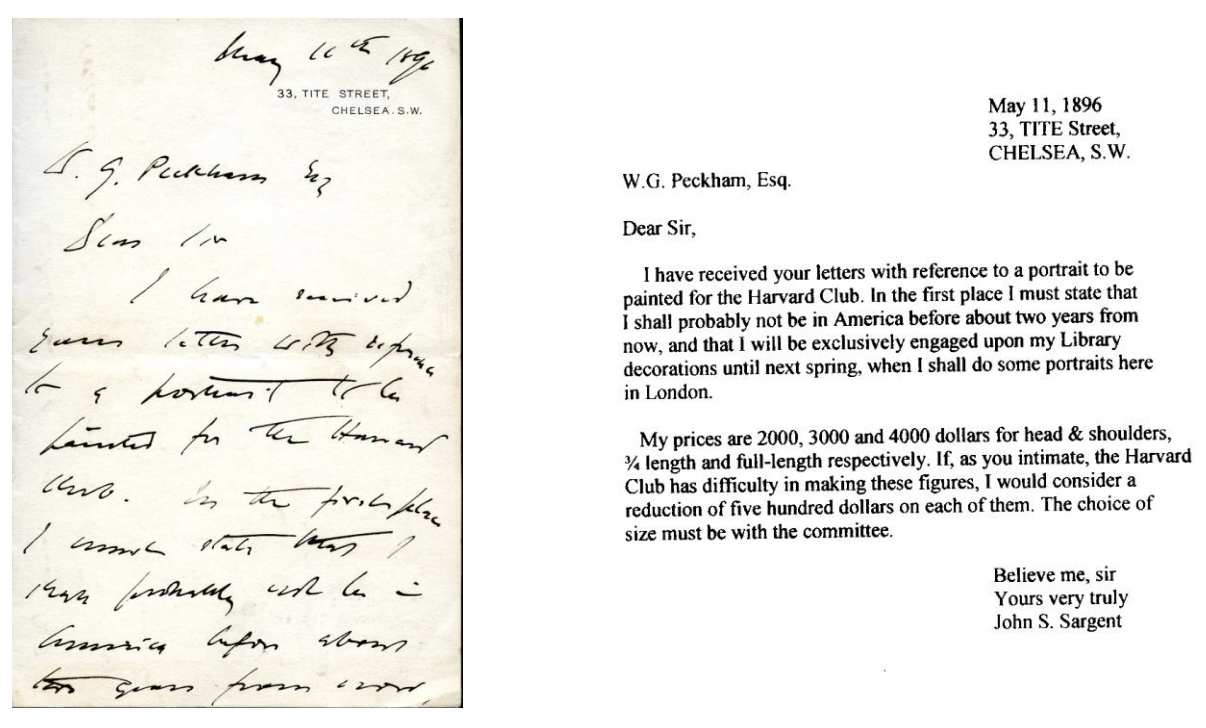
Here is a quote from John S. Sargent forr a portrait for the Harvard Club.
$2,000 for head and shoulders
$3,000 for 3/4 length
$4,000 for full length
Sounds a fair price, but this was 1896.
The equivalent today would be:
$73,432.62 for head and shoulders
$110,148.93 for 3/4 length
$146,865.24 for full length
Capturing the Light
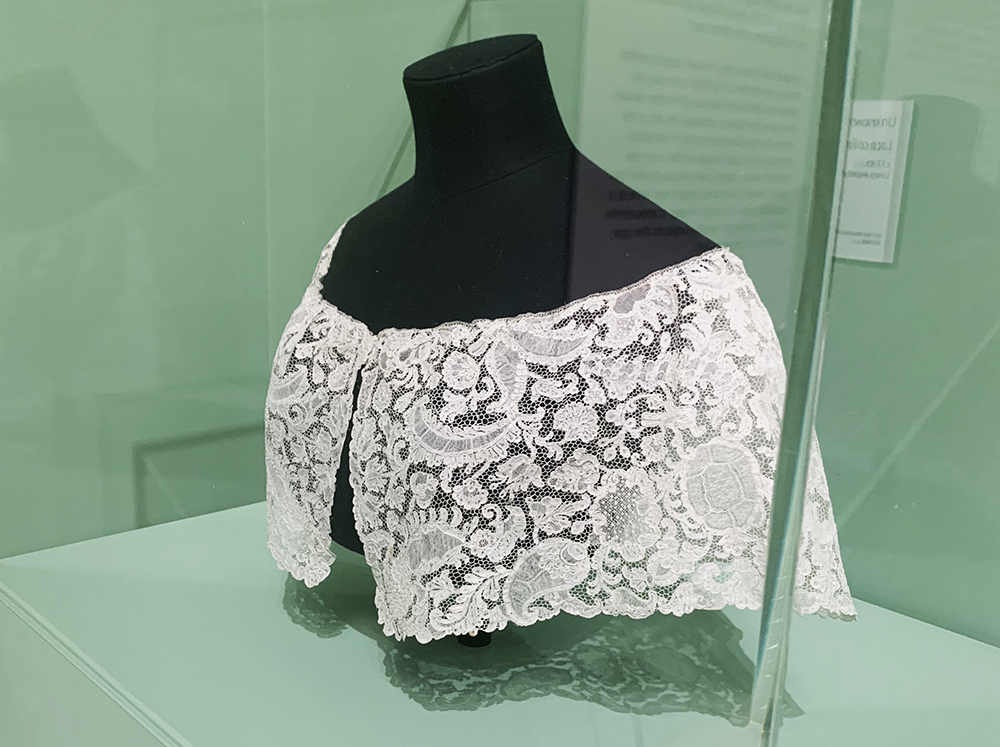
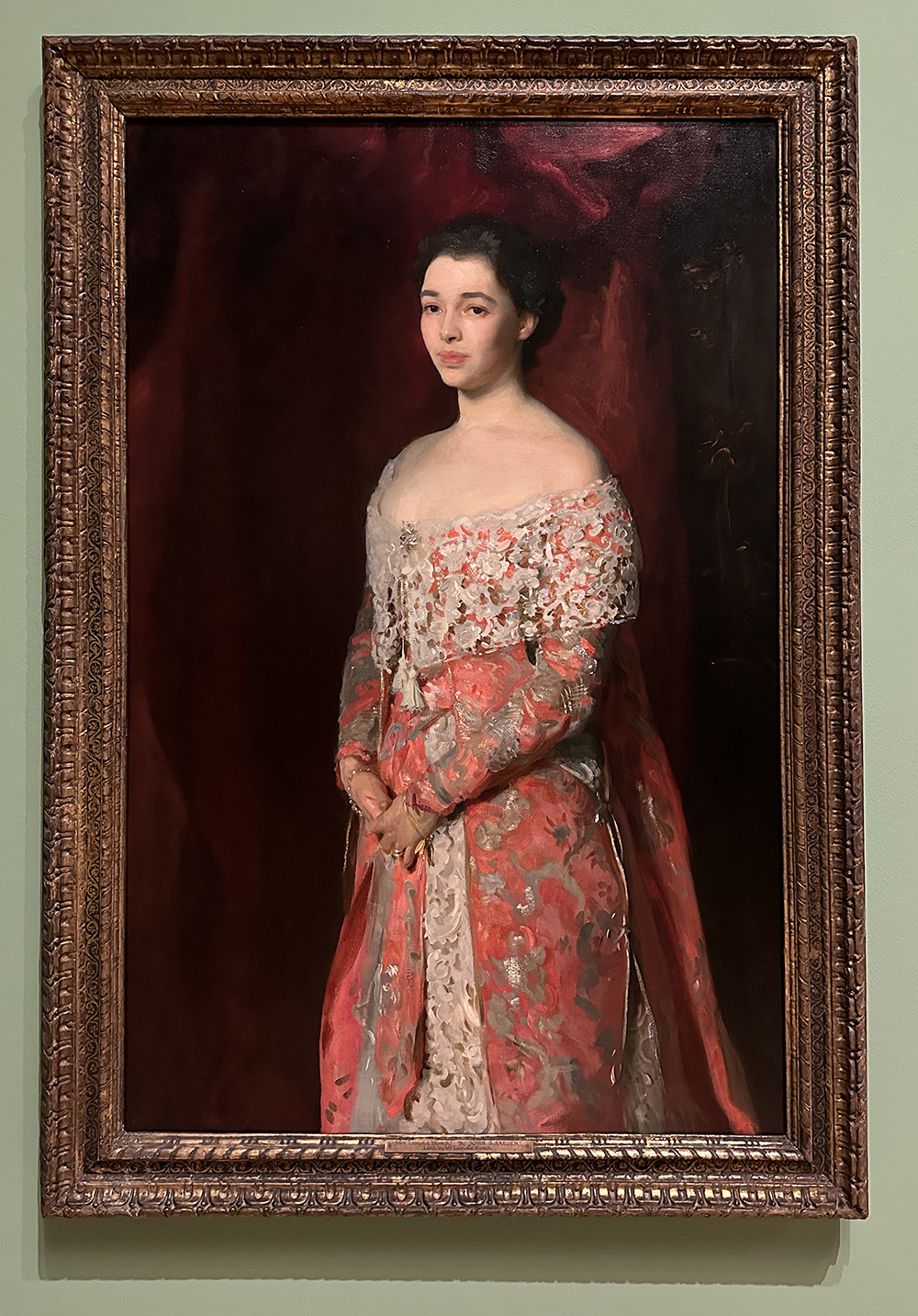
Mrs Leoplold Hirsch, John Singer Sargent, Oil on Canvas, 1902
This is such an amazing painting of Mathilde Hirsch.
A passionate historian and collector of paintings and furniture may have inspired her choice of antique lace for her collar. The mark-making and brushstrokes are multilayered. They feel very frenetic when standing close to the painting, but the overall portrait is very serene.
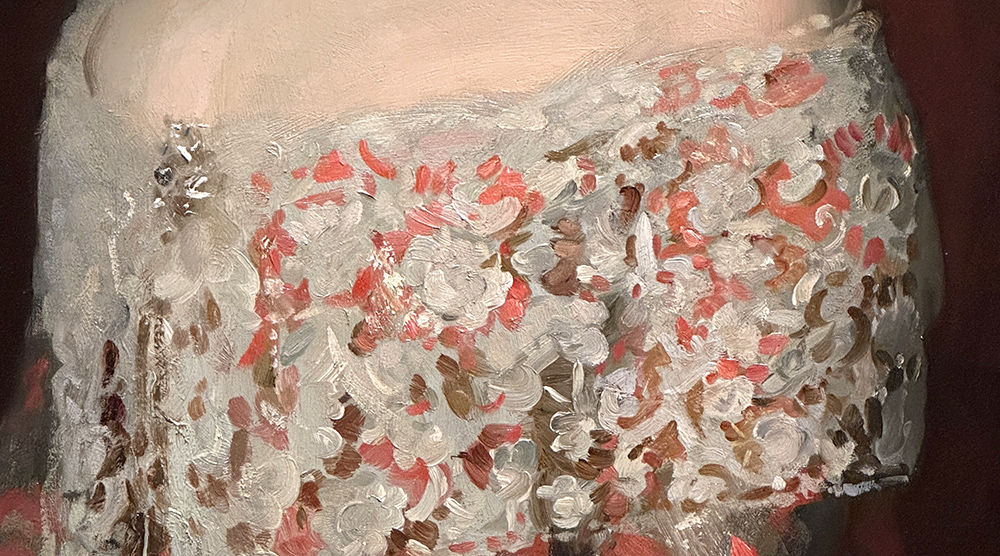
Detail of lace collar
When you highlight just that central area, see how the form changes and the values of the skin tones are so subtle. It’s only when you see it in the context of the rest of the painting that suddenly, it feels a lot more three-dimensional and elegant.
What Sargent is so good at capturing, is light fall-off. It’s all about how the light drops in a scene and how he just seems to control where you look just from the fall off of the light.
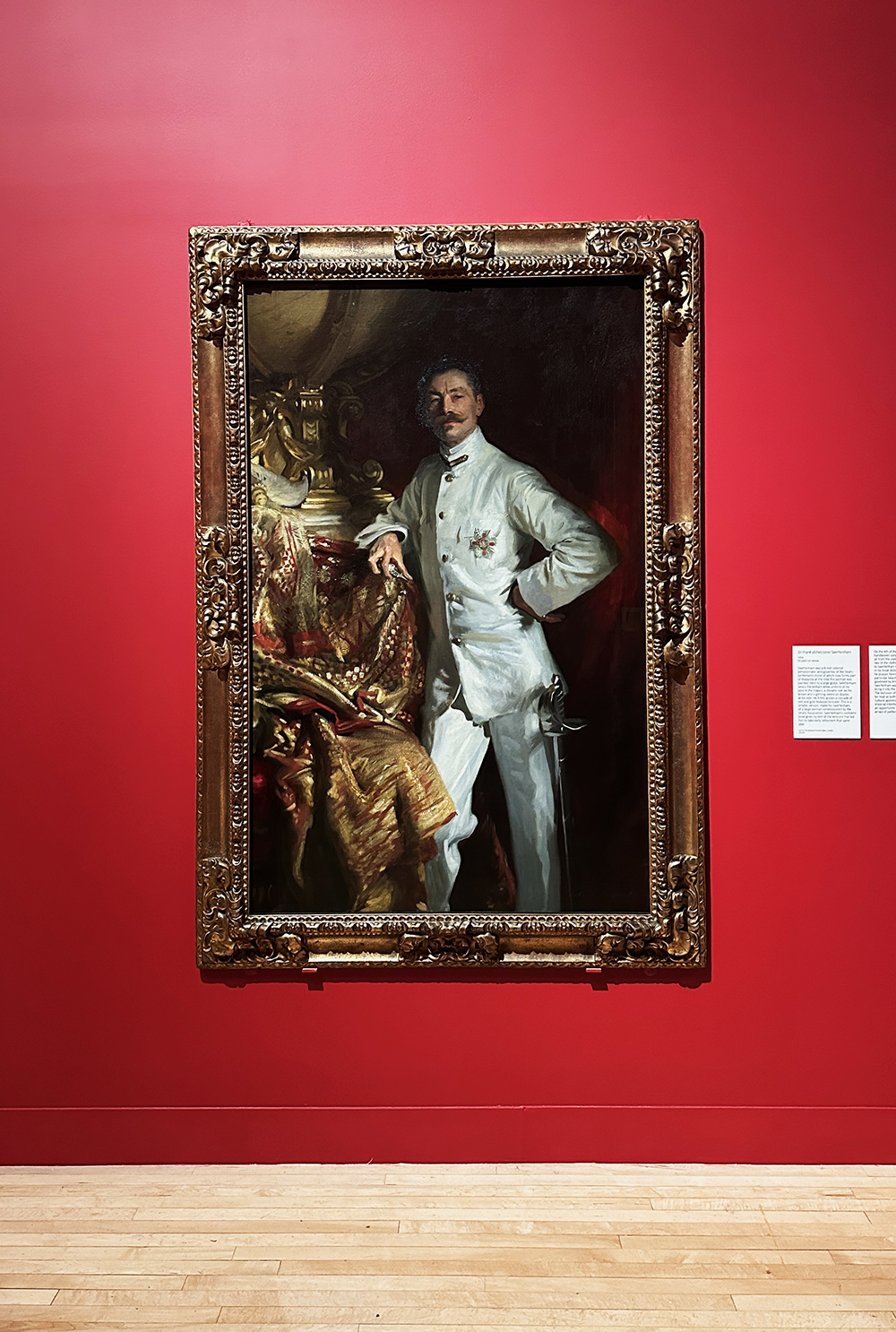
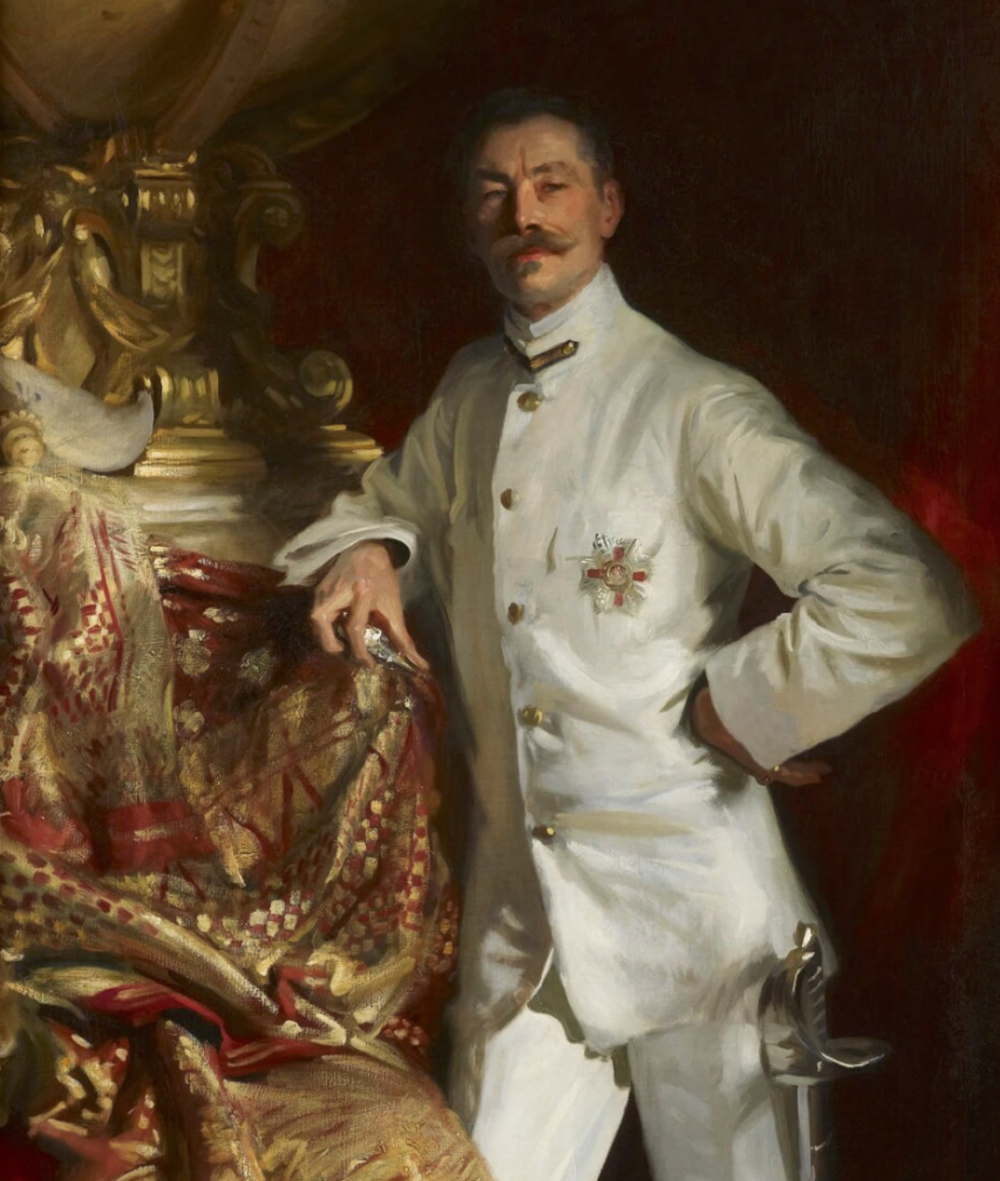
Sir Frank (Athelstane) Swettenham, John Singer Sargent, Oil on Canvas, 1904
The portrait above of Sir Frank Swettenham is often reproduced in books, and they pump up his face so it looks like you can see him more, but that isn’t how the portrait actually looks.
It’s really dark on his face, and his trousers are the brightest part. Sargent is brave enough to flip it around. Rather than always focusing on the face, the trousers are the lightest value, and the figure emerges from the background.
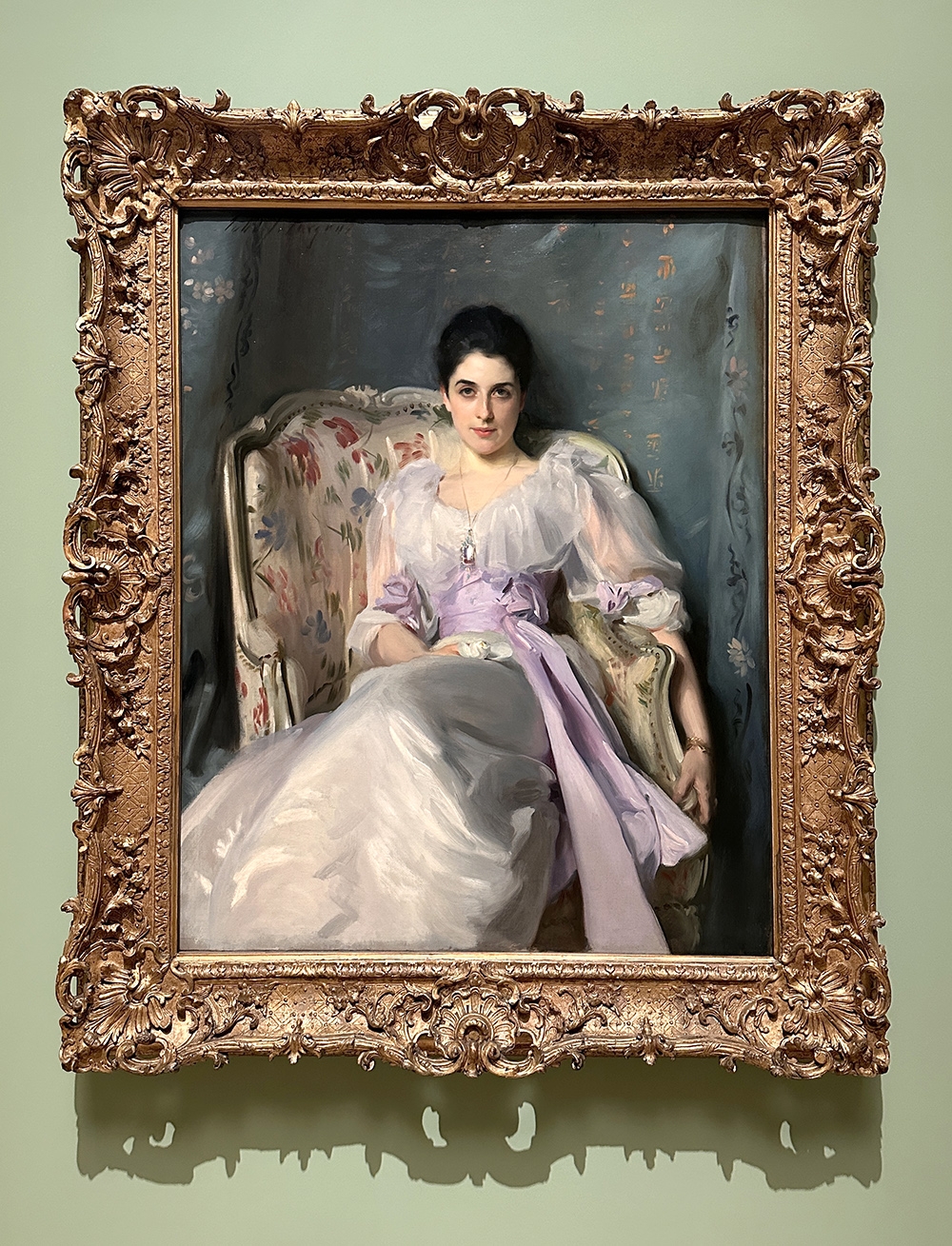
Lady Agnew of Lochnaw, John Singer Sargent, Oil on Canvas, 1892
Sargent visited Lady Agnew in her London home to discuss her portrait and consider different gowns, finally deciding on a white sheer organza and silk dress with lavender accessories.
This is such a beautiful painting, and if you compare Lady Agnew’s hands, which are held together, quite hidden and subdued, compared to Madame X’s hands, which are very stylised, you’re now in this painting, just concentrated on the face.
I always think if you look at someone’s hands and how they use them, you can begin to see the character, how they’re holding their pose, so you’ve got to think about when you’re painting a portrait of a whole figure.
Does this subject work with the hands or tell a story using them, are you even going to highlight that or not? It’s not just about the face, it’s about the whole character.
The hands can be gestural and portray a mood. Whatever the hands are doing is often a reflection of what the sitter’s mind is doing.

He painted quickly, completed this portrait in just six sittings.
And if you are ever struggling to paint white, study this portrait. I know she’s got a bit of colour in the purple sash, but look how many colours are in the white gown.
There’s purples, yellows, and dark blues, and then there’s some pure white too. It’s also amazing how he then has the see-through sleeves of the top, and you can see her arm beneath it. In the top right corner, how has he even painted the organza so beautifully?
When you get up close other bits are so bold and quick. The sash is beautiful, it’s so incredibly simple. And I think it’s fabulous to see these very complicated fabrics Sargent manages to convey in a very simple way, but when you stand in front of the painting, you’re really just drawn to her face.
You’re taking in the rest, but he’s managed to control the edges and softness so that her actual face is the sharpest, most focused, most finished part. He has an amazing way of putting weight into people. I don’t quite know how he does it, but you feel like she’s sitting in a chair with her legs out and resting on the side.

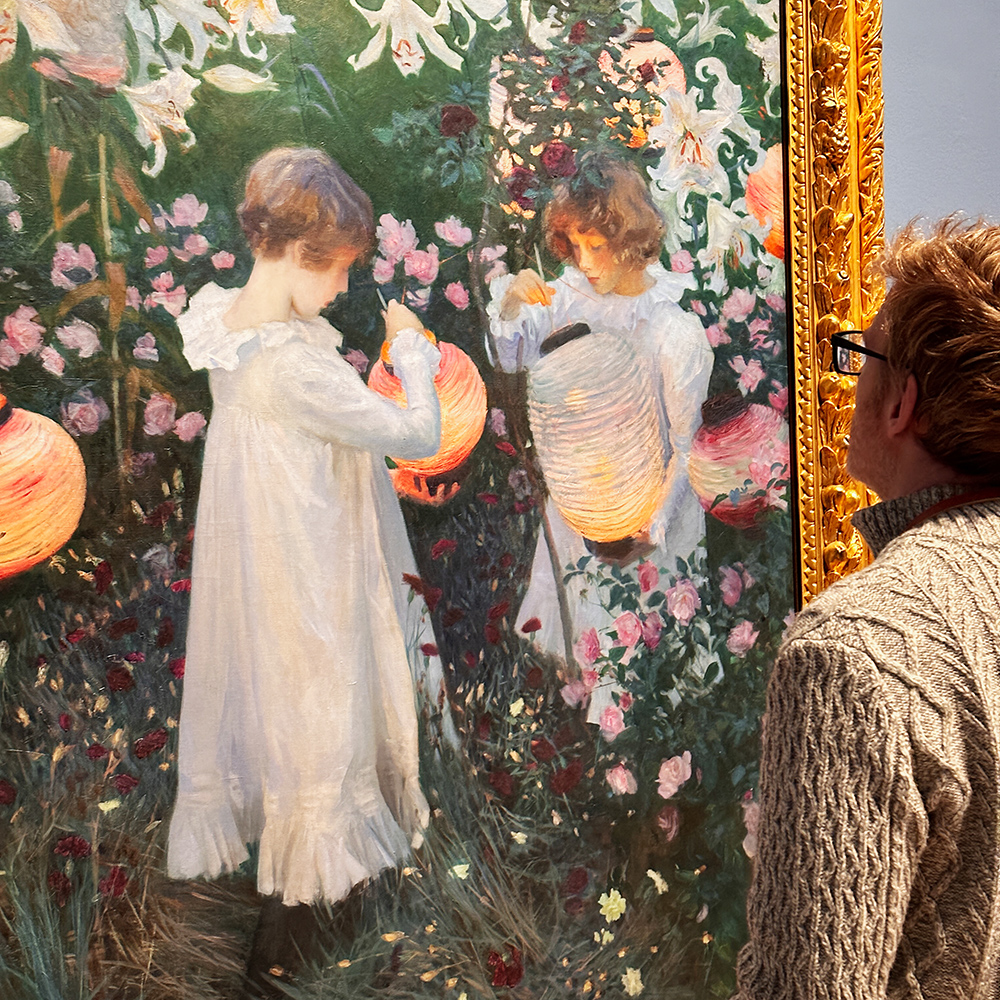
Carnation, Lily, Lily, Rose, John Singer Sargent, Oil on Canvas, 1885-6
This is one of Sargent’s first paintings after moving from Paris to London. It was created in Broadway, a quaint, peaceful village set in the Cotswolds where Sargent stayed with his friend and fellow painter Millet.
(You can see some photos of Broadway in this article: Inspiration, Impressionism & the Power of Environment)
It has always been a magical painting, for me and I remember as a student, being blown away by how compelling the light is.
He painted it over two years, mostly outside in the few minutes when the light was perfect, giving the picture an overall purple glow of evening light. He was inspired by the Chinese lanterns hanging amongst the trees and lilies in full bloom in the garden and added the two girls, the daughters of the illustrator Frederick Barnard wearing white dresses he had specially made.
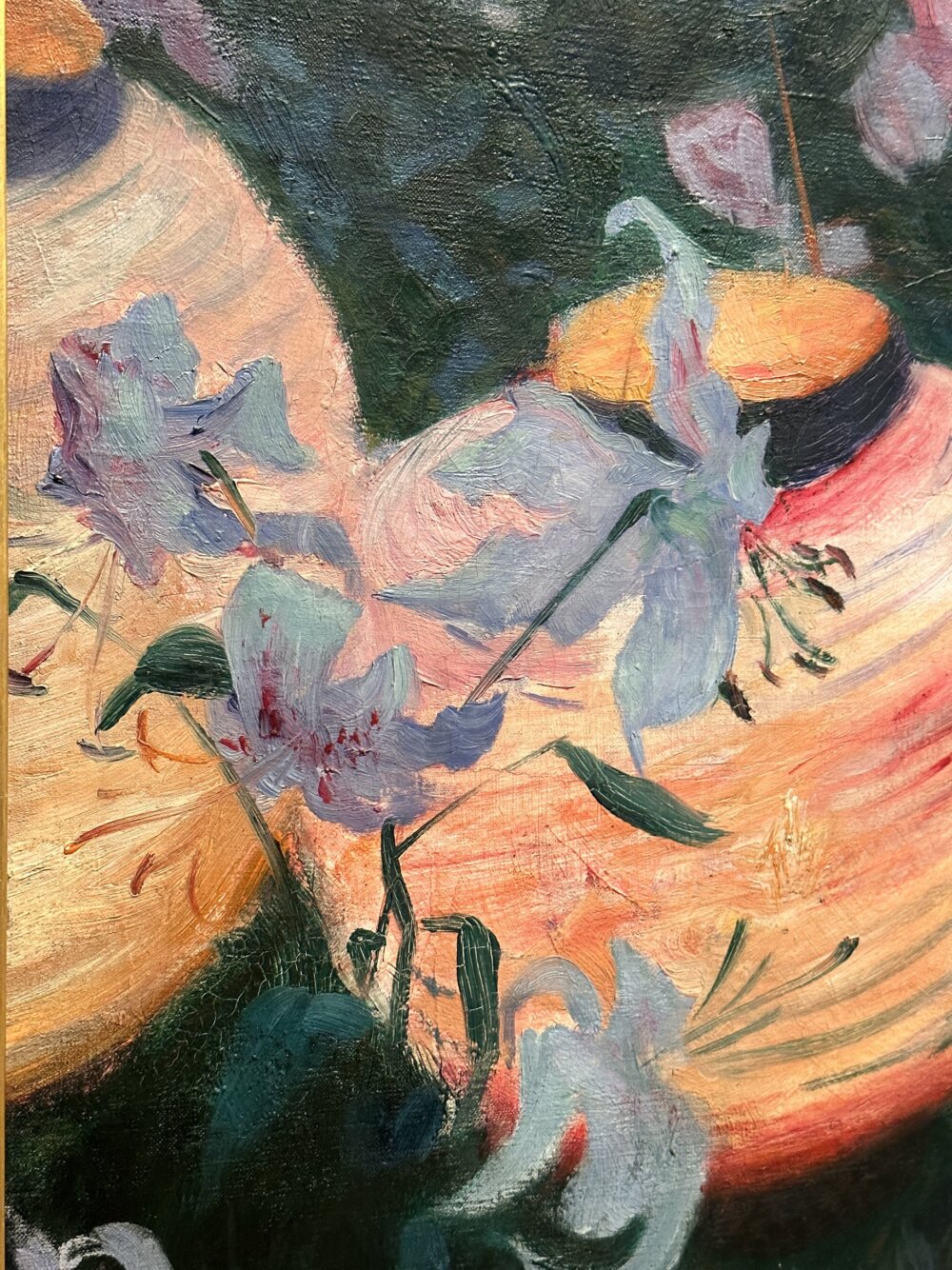
When you look at this compared to Lady Agnew above , it doesn’t have that same sense of freedom of movement or the very confident, free-flowing brush marks.
But what works incredibly well in Carnation, Lily, Lily Rose, which works well in all Sargent, is his graphical composition elements, like the shapes around the lilies. The way he composes the scene is so good. Like that kind of holds it all together.
Interestingly, this painting was created after leaving Paris and the Madame X scandal.
He was very anxious during this period, aiming to get back his reputation, so it feels like, in parts, it has been overpainted. As a reference point Lady Agnew was painted six or seven years later, by which point he’s relaxed and back in his stride.
The later works feel almost effortless. Take it or leave it.
As a painter you can’t help but let criticisms crowd your mind. There is nothing worse than having an expectation on your shoulders. I also think in exhibitions, it’s hard to tell the timelines when you’re walking through, most shows are based on a theme, but it’s interesting to see what else was happening in his life at the time the work was created.
Performance and Posture
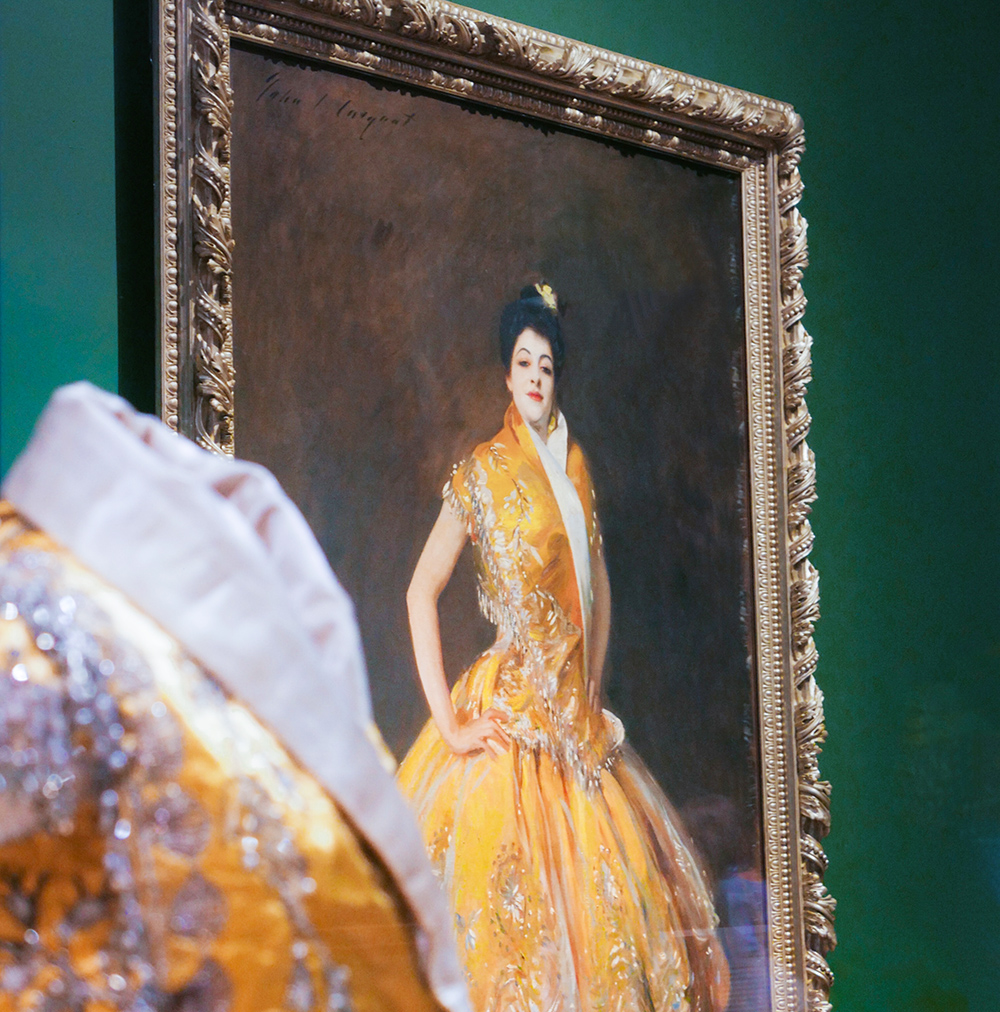
La Carmencita, John Singer Sargent, Oil on Canvas, 1890
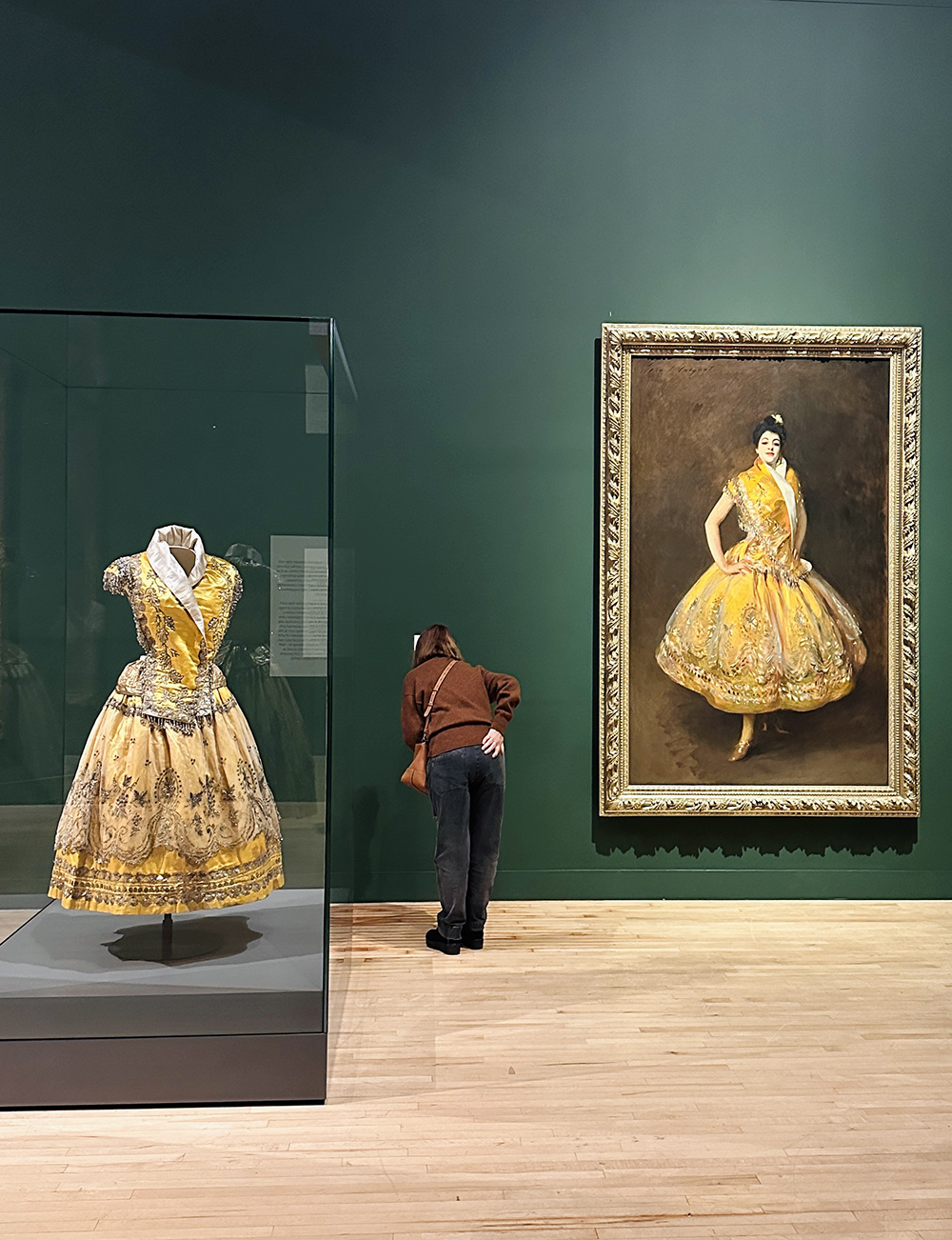
Some of the Sargent sitters, such as Ellen Terry and Carmencita, were professional performers who appealed to Sargent’s love of music and theatre.
Carmen Dauset Moreno better known as Carmencita, was a Spanish dancer who performed internationally. Known for her twisting and twirling dance style, Sargent captured her in a very posed stance; but her shimmering, heavily decorated dress adds real life and movement to the painting.
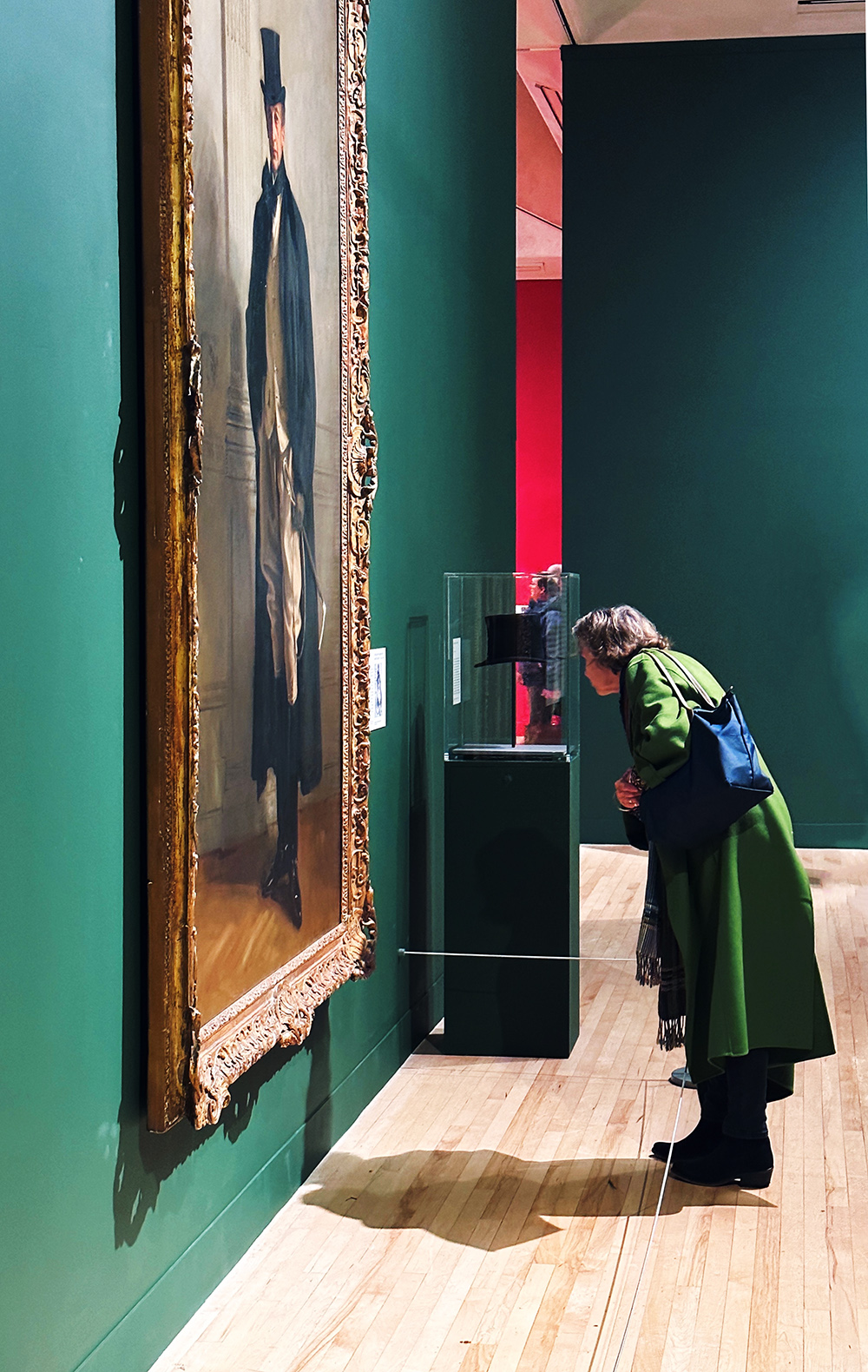
Lord Ribblesdale John Singer Sargent, Oil on Canvas, 1902
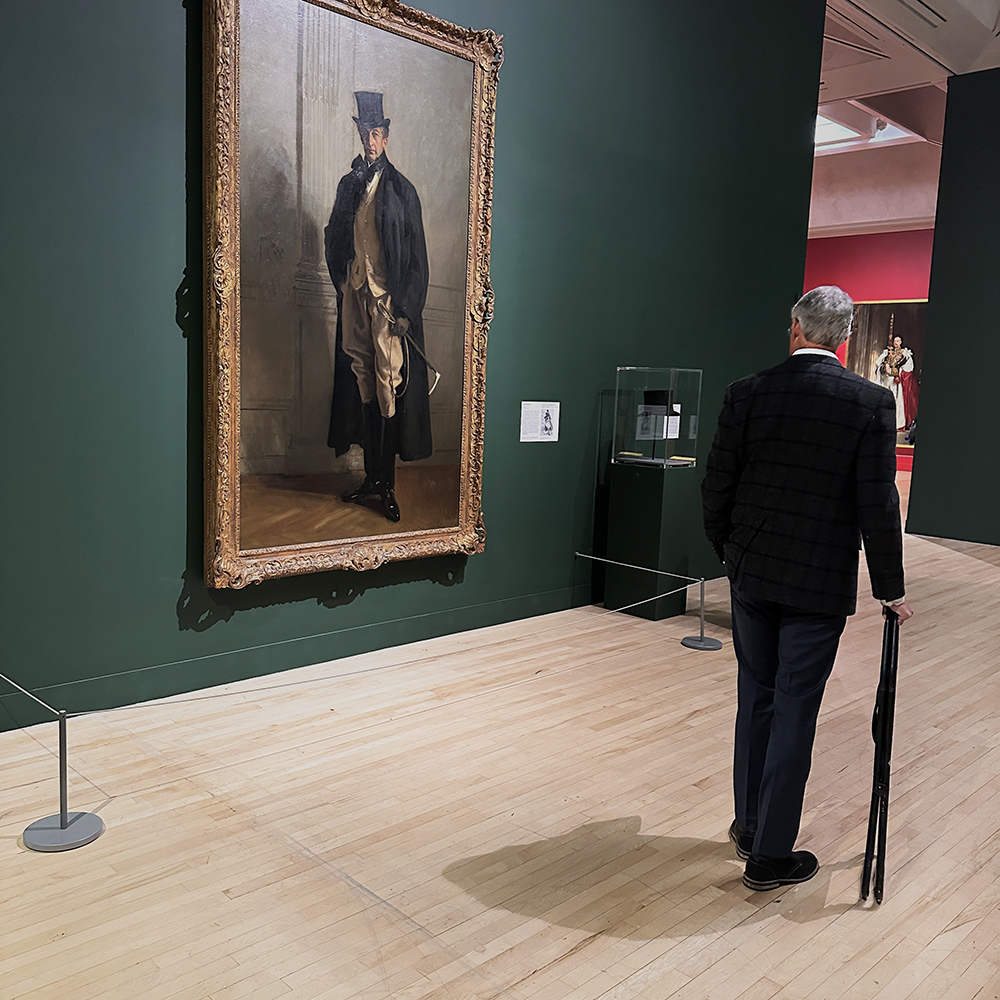
Sitters such as Lord Ribblesdale were society personalities, he paid fastidious attention to his appearance in the everyday. In this portrait Sargent exaggerated the proportions of his silk tie and breeches.
By having some of the actual garments that Sargent painted, you have a unique opportunity to look at the fabric and folds and try to decide what you would include. How does the surface reflect light? What is the hue and the saturation? What parts of the essence describe the object without getting overly fussy or detailed?
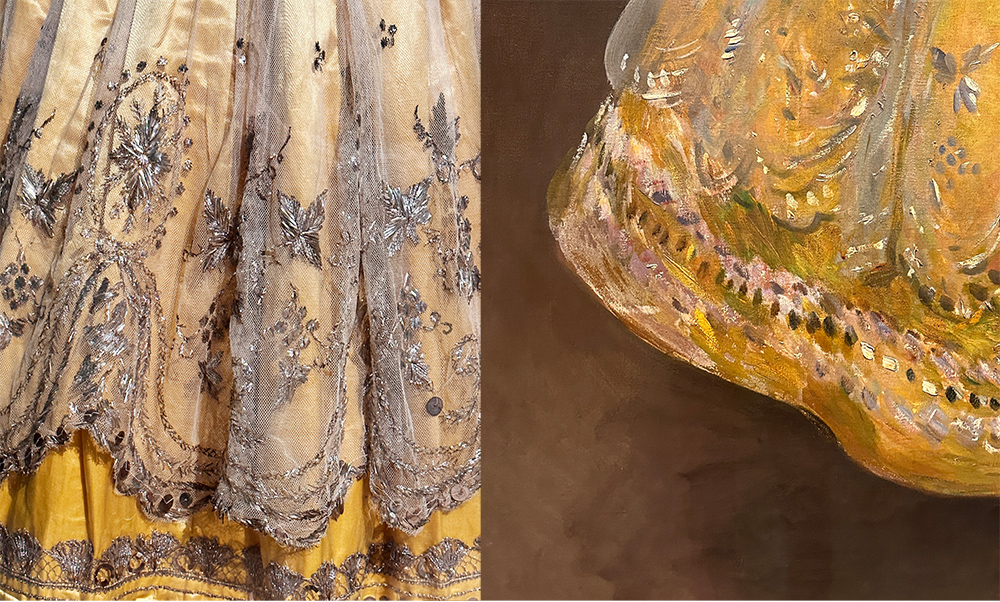
Detail of the fabric in comparison to the painting interpretation.
When you’re painting impressionistic, the question is what don’t I paint? Not what can I add more of, but what can I take away from the subject and still tell the story of this object? So it’s like stripping it back down to how simple you can go without getting overly simplified.
You can see what Sargent focuses on compared to the finished painting. So find some fabric, place it next to a light, and observe the shapes.
A great practice when you’re learning to paint is to create a ‘master copy’. This is where you try to re-create a painting in the style of an artist you admire. The biggest thing the artist has already done for you is decipher the real-life image into more simplistic form that describes the subject.
Travels
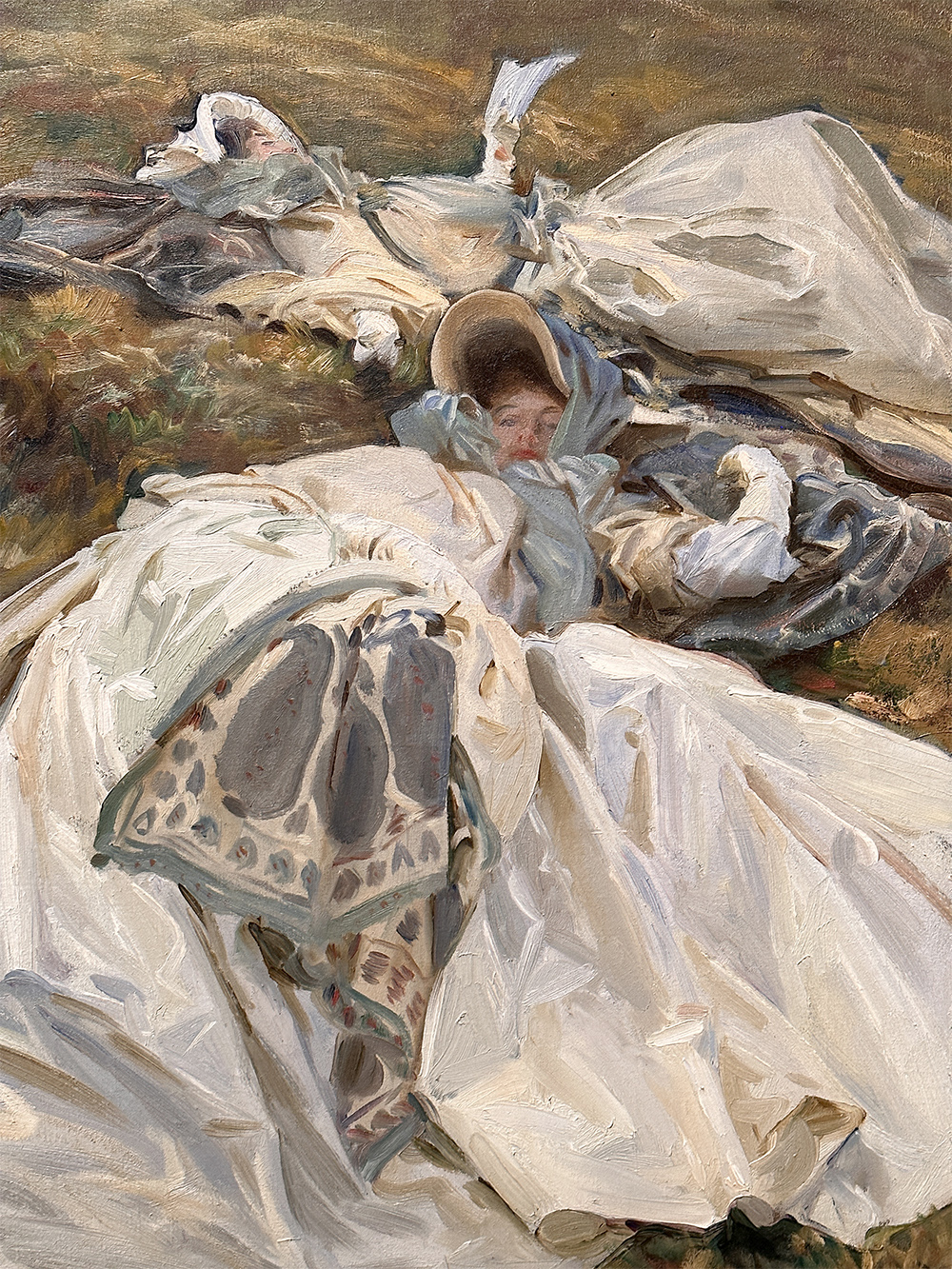
Two Girls in White Dresses, John Singer Sargent, Oil on Canvas, 1911
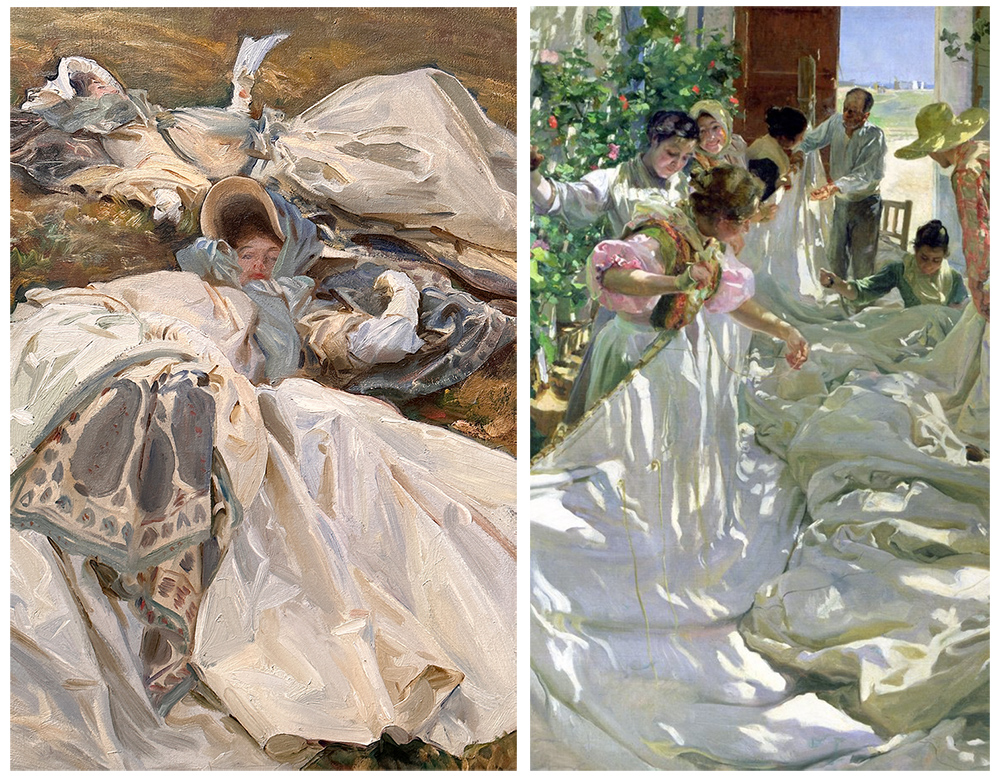
Left: Singer Sargent, Right: Sorolla.
Sargent travelled extensively during the summer and made many paintings of his travelling companions.
In these works, the figures are nonchalant, allowing the clothing to take centre stage. These are unnamed people, painted outside, and I think they’re some of his most popular pieces. Sargent’s most expensive painting Group with Parasols (A Siesta) sold at Sotheby’s in 2004 for $23,528,000 dollars.
They are his most impressionistic works, capturing that sense of movement; but you can see he’s still obsessed with fabric and working on graphic elements.
It reminded me of Sorolla’s ‘Mending the Sails’ above because of the confidence to have a piece of white fabric as the central element to a composition. Sargent had a chance to experiment with fabric and texture in ways that would be impossible to do within the structure of a society portrait.
He was beginning to feel tired of making people look a certain way, it must have been like doing a Tatler shoot! He just said I’m just not interested in that anymore, and stopped oil portrait commissions when he was in his early 50s.
Much of his later career was dedicated to large-scale murals, he also served as a war artist during the First World War, when he made his largest oil paintings.
Sargent still occasionally painted friends and his final portraits are those of an artist with nothing left to prove.
The exhibition is called Sargent and Fashion, but I think Sargent and Fabric would have been more fitting, its on all Summer so hopefully you can get a chance to visit.
The show runs until 7th July 2024 : Sargent and Fashion

Apres Exhibition at the Tate cafe
P.S. I’d also like to thank reader Raquel, who first alerted me to the show when it was on in Boston, thanks!





Oh my goodness, this is so wonderful, and thanks for posting, Will! Singer is my favorite portrait painter and to see so many of his works alongside the costumes the figures wore for their sittings is such a bonus. I will Google the show to see if perhaps it will be touring the States. The pastries, BTW, looked delicious!
cheers.
Grace
So pleased you enjoyed it Grace.
Will
So great that you took the time to create and share this! Thanks so much.
My pleasure Sharon.
Will. Thank you, thank you, thank you! Absolutely mesmerising. A fantastic story that brings to life the extraordinary talent of this unique artist. Cheap at the price when you look carefully at his work. What a privilege it must have been to visit and see his work. And to understand that many of his paintings of clothes still exist.
Your piece is worth reading often.
Glorious Will.
Thanks so much Charles, pleased you enjoyed the article.
Will
Thank you so much for this incredibly interesting exhibition. I had read a couple of lack lustre reviews,( grumbling that the paintings had been out-staged by the fashion ) had deterred me from making the ( expensive) trip to London to see it, but your analysis from the ‘viewpoint of a painter’ and the challenges of painting fabric really changed my mind!!! Booking my train ticket immediately
So pleased you found it helpful Louise, hope you have a great time.
Will
WOW! Thanks so much for this Will – it really captures the exhibition and wonderful work of Sargent. I love trying to paint fabric so it’s illuminating to see the dresses etc. His brush marks are extraordinary – so much to take in. I love the history and street scenes too.And of course the pastries ! Must get up to London to see it.
All the best
Michelle
\
Thanks Michelle, hope it helps with painting fabric.
Will
I mean c’mon. What a truly spectacular commentary. Thank you, Will. I am rereading this. And keeping it to savor. Just so beautifully written.
Ahh, thanks so much Julie, so pleased you enjoyed it.
Will
Great article with perfect photos of your message. I learned a lot. Love Sargent’s work! Thank you, Will.
That’s great to hear Ree.
I love your insights on this exhibit and the pictures of his studio.
I did get to see this exhibit in Boston and it was a highlight of my fall.
Thanks for going into such wonderful detail and comparisons of Sargents works.
So pleased you managed to catch the show in Boston Janice.
Thank you, thank you, Will – I so enjoyed this article/story/lesson/ tour,
Vicki
Fab stuff Vicki, pleased you enjoyed it.
Will
Will, thank you for sharing this exquisite exhibit! I enjoyed reading every word of your commentary.
You’re very kind Gail, thanks.
Thanks so much Will for this insight into the exhibition and John Singer Sargent, an artist that I knew little about. The cakes look great, too!
My pleasure David, glad you enjoyed learning about his life and works.
Will
I also saw the show in Boston in January. It was amazing and as I walked through the exhibit I recalled things you had brought to my attention about Sargent in your drawing courses. It made it that much more worthwhile. Thanks again for ever expanding my horizons!.
Oh brilliant stuff Kathy.
What a great post – thank you! The comment you made about hands had never occurred to me, but of course it’s very true – the way people hold and use their hands is a very revealing element of their character. Thank you for sharing the exhibition with those of us who won’t be able to see it.
Two other things occur to me – modern everyday clothes are so dingy in comparison! And the cake at the end actually looks like a good subject for a painting too!
So pleased you enjoyed it Katherine, and well spotted with the final image…tbc!
Will
Thanks so much for take a time to do and share this wonderful work!.
Hope you enjoyed the tour Lily.
Such an informative and entertaining article!! Thank you for the lovely virtual tour!!
Thanks Nour, glad you enjoyed reading about the show.
Will
How stimulating Will! Thank you for sharing your visit (complete with delicious pastries). Love all your observations on Sargent’s way of catching the light and directing our eye around the painting. Will certainly look at my painting with a different eye. Thank you again.
That’s great to hear Cecilia.
Will
Hi Will. So grateful to you for bringing us with you on this amazing tour of the Tate and the works of JSS! You’ve given me such joy, here in the cold and snowy Canadian Rockies!!! My heart is full. Thank you again.
My pleasure Lori, so pleased you enjoyed it.
Will
Thank-you for drawing my eyes to aspects of the paintings that I would have missed on my own. Much appreciated Will.
Oh that’s great to hear Carrie, pleased it was insightful.
Thank you so much, Will, for taking the time to share this exhibition and your wonderful insights into the way Sargent worked. Your reviews enrich my understanding of art and artists immensely, and have led me to a much deeper appreciation of their work – and of paintings generally.
That’s fabulous to hear Kate, glad you’ve been able to see the works through new eyes.
Will
Thanks for the Singer Sargent post Will, it explains his skills so well, especially the contrasting loose brush marks on the fabrics against the smooth skin textures & tones. I feel like I’ve learned a lot by reading your explanations of his work & talent. Thank you for taking the time that the post must have taken & pleased you enjoyed the pastry! Hope you’re now settled into your new studio & home. John
Ah thanks John, yes, I do find pastries seem to enhance the experience!
Will,
Thank you, thank you for your insights on my favorite painter’s technique and life. The vividness of his fabrics, personalities and scenes always enthrall me. I got to see Lady Agnew in person years ago in Boston, and I can’t articulate how much she glowed- the intensity of the gaze and the superb lavender gown-goosebumps!
Was the paisley shawl on display?
With much appreciation,
Alice
Hey Alice, great that you’ve been able to see the Lady Agnew in person, it’s such a great painting. No fabrics to complement the painting.
Will
Thanks for an excellent review Will. I’m going in a couple of weeks time and this has really whetted my appetite… also the bakery items! Great insights
Brilliant stuff Shirley, hope you have a fantastic time.
Will
Thank you so much for this article Will. I would like to visit the exhibition too. Bakery also a nice addition to the tour.
Thanks Katerina, so pleased you enjoyed it.
Hello Will,
another vivid story from you. Thanks for sharing it. I´d loved to take a bite off that almond croissant and of course I will now try to see the exhibition for myself. There´s been a large review in the german “ART”-magazine, but your observations and comments are much better because of the professional details.
Singer-Sargent ist one of my favorite painters. I´ve seen “Madame X” in New York and what strikes me most, that you can not see a trace of his revision of the strap.
And of course I admire his gestural brushwork. It looks so easy, just a dab of paint, but when you try to reproduce it, you realize what a mastery it takes.
Cheers
Kai
Hey Kai, great to hear from you, yes, it was delicious. Glad the details helped and you manage to catch the show.
Will
Wow! Will thank you so much for a great article and showing pictures of the exhibit!
My pleasure Sharon, so pleased you enjoyed it.
Will
Will – This was fabulous! Thank you for making the effort to share this experience. Also – thanks for your words reminding me: “When you’re painting impressionistic, the question is what don’t I paint? Not what can I add more of, but what can I take away from the subject and still tell the story of this object? So it’s like stripping it back down to how simple you can go without getting overly simplified.” Loved the bakery shots too:) Cheers! Karen
Glad you found it helpful Karen, yes, you can even experiment to pushing an image into abstraction and then coming back from that. Like a sliding scale of realism.
Will
Hi Will
I so enjoyed your piece about the Sargent exhibition. You drew my attention to things I would have never noticed. The painting with the lanterns was one of the first paintings which impressed me as a girl, but all his paintings are enchanting. Thank you.
Thanks for reading Helen, so pleased you enjoyed it.
Will
Thank you so much for investing so much time in writing this review. You shared so much information that it was almost better than being there!
Ahh, you’re too kind Kathy, thanks.
I’m so glad you got to see the Sargent & Fashion show, Will. I saw it in Boston and absolutely loved it. It’s been wonderful to see it again through your eyes, thank you!
Great stuff Susan, so pleased you managed to catch it in Boston.
I loved this, being very much into textiles and costumery. A decade ago I did a similar thing (including the croissant) on a visit to London. Thank you.
Hope it brought back good memories of your trip Robyn.
Just amazing! I am lucky to be going soon! What an exciting visit! Sadly 88 this year to old to attend Will Kemp’s Art Course!
Really hope you enjoy the show Pat.
Saw it a couple of months ago in Boston. Wonderful show. I found especially interesting how abstract some of it looks up close.
Thanks for bringing it all back to mind.
Yes they really do don’t they Tom, great that you were able to catch it.
Will , thank you for this , it is a very pleasing article of what you saw and brought to us , love the way you articulate the minds eye veiw , the paintings you show are the cream of the Sargents portraitures for me anyway …. Your knowledge of Sargent is the most valued I’ve read so far Always a giggle (the treats ) … much enjoyed
Thanks so much Kim, that’s lovely to hear.
Thanks Will for the art history lesson. You are special in that way. I am not familiar with any artist who expends the time it requires to give such a comprehensive lesson on line.
Glad you enjoyed learning about Sargent’s work Jean.
Hi Will
Thank you so, so much for taking the time to photograph parts of the exhibition and then put together this wonderful post, for all to enjoy.
I live in Australia and thus do not have the opportunity to visit the gallery, so I appreciate this precis, dearly!
Many, many thanks
Linda
Fab that you enjoyed the virtual tour Linda!
Thank you Will for sharing Singer-Sargent Exhibition. A true example of “every brush stroke has its place” never to be over worked, such confidence of a truly great artist.
Ann, Australia
Hey Ann, yes the later pieces really have that sense of one brushtroke capturing a lot of information within it, glad you enjoyed the article.
Thanks for a wonderful article Will it has bought the exhibition into my hands! Now to book the train ticket!
Go for it Wendy, you’ll have a fantastic time, so many more portraits that I didn’t feature.
Will
Oh wow looks like a wonderful exhibition had I realized it was in London at this time I might have gone to London instead of Greece for holidays. Thank you for sharing it with us.
Glad you enjoyed it Jackie, enjoy your break.
Thank you for the absolutely wonderful article! Your insights on the paintings bring them to life! I saw La Carmencita a few years ago in the exhibition in San Francisco on Sargent and Spain and was mesmerized by the fabric and light in La Carmencita and by the whites and the motion conveyed in La Carmencita dancing! I wish I could see this exhibit!
My pleasure Sherri, yes La Carmencita is such a great painting, glad you got to see it in San Francisco.
Will
Thank you so much Will for such an interesting and enjoyable post. You have given me a reason to make that trip up to London!
Thanks Kate, glad you found it of interest.
This is just beautiful Will, I’ve read it twice, first time with a brew and a couple of biscuits! Thank you ever so much
Julia
A second read is always another a chance for more biscuits! Glad you enjooyed it Julia.
Thank you so much for this amazing article.
Two years ago i was introduced to Sargent in my art class.
I really enjoyed your detailed analysis of each painting
Thanks Shiva, pleased it was helpful.
Thank you so much for creating this amazing detailed review. I love that you describe things from a painter’s eye rather than a critic’s eye and I have come away seeing more clearly than if I had been at the exhibition myself… which I am not likely to see so thank you again!
That’s great to hear Lucky, so pleased you found the descriptions helpful.
Will
Hi Will
What a treat – an exhibition of paintings reviewed by a painter! Your insights are so valuable. Thank you for this excellent piece. I’m going to see the show in a couple of weeks and this is the best ever preparation for it.
Oh great stuff Claire, so pleased it was timely for you.
Will
Thanks, Will. A superb exhibition. Singer Sargent certainly was a master of painting light. His innate skill of painting accurate figure proportions wearing heavy fabrics is superb. Interesting that he chose to paint Sir Frank Swetthenham’s upper body in subdued values, given the brightness of his clothing. Not sure why. I am pleased you remarked on the loose brushwork that shows detail from a distance.
Some of the skin tones do appear a little bright, though, particularly in the face. Which I don’t ever remember seeing in a Van Dyck or a Rembrandt painting. Perhaps it was the makeup used in the Victorian era, not often seen today.
Singer Sargent set a very high standard for portraiture artists. I am sure his friend Monet would have encouraged him to paint the way he chose, rather than altering Madame X’s dress strap to satisfy overbearing people in high Parisian society. He was a wonderful artist, who continues to inspire me.
Hey Paul, yes makeup was used to lighten the value of skintones. Glad you enjoyed it.
Will
How wonderful and generous of you to share all this beauty, I really enjoyed it and now I am ready to paint!
So pleased you’re feeling inspired Camille.
Thanks for sharing your detailed report on the Singer Sargent exhibition Will which I will ensure to visit. I have always been an admirer and follower of this great artist and bought the book ‘John Singer Sargent his portrait ‘ by Stanley Olsen from a second hand book dealer and highly recommend it to anyone that hasn’t read it. I too love the painting ‘Carnation, Lily, Lily, Rose’, which incidentally Sargent nicknamed ‘Damnation, Silly, Silly Pose’, presumably because it took him such a long time to execute! Another favourite of mine, which I have see is ‘The Pailleron Children’ his sensational and sensitive brushstrokes in the little girls dress and shoes I found so moving. Thanks again. Ruth
Ha, ha, hadn’t heard that one before Ruth, thanks for the book tip.
Will
Thank you so much for this walk-through. I love John Singer Sargent, and I have always been drawn to his portraits. It is quite thrilling to see the original dresses; it really makes you wonder how you would approach the piece. Sadly, I will not see the exhibit because I am in Canada, so this was a terrific chance to see the exhibit through your eyes. Thanks again.
Hey Sonja, really hope it helped it bring some of the paintings closer to home.
Will
Thank you so much for this post Will, I am not able to get to art galleries any more due to commitments at home so really enjoy all your posts like this.
No exception here, it was a thoroughly enjoyable journey with your excellent commentary. Lots of best wishes. Sue.
Fantastic to hear you enjoyed it Sue.
WOW . . . what an exhibit! It was amazing to see those paintings up close and how he left out a lot of detail, but still captured the beauty of the fabrics and subject. Now we need paintings of your delish-looking snacks, hehehe!
You alway find the greatest subjects/stories to share.
Have a good week on purpose!
Thanks Laundrea, glad you enjoyed seeing the paintings details.
Well done, Will! Thank you so much!!!
God bless you and yours, C-Marie
Thanks C-Marie.
I am in awe at the amount of work you have put in to give us an appreciation of an artist that I didn’t know that well. I particularly liked how the costumes could come to life in a painting. I think you needed all those sugar rushes to keep your energy up to aid bringing all this post to your appreciative audience. Thanks once again.
Ha, ha so true Rita, so pleased you enjoyed reading about Sargent.
Will
Thank so much Will, for taking us on your London adventure, to the very home and studio of the great artist, through the sampling of fine pastries and then on to the examination of the paintings themselves, the comparison to the fabric and garments accompanying them. Sharing your artist’s viewpoint is very valuable. Thanks so much.
My pleasure Maria, glad you enjoyed the journey.
Will
Thank you Will for your excellent review. I just saw the show last Thursday. I was surprised by the size of the show. To see so much of Sargent’s work side by side really gave an understanding of how he handled the challenges of painting fabric. Seeing a large body of work like this helps you see how the artist thinks and answers the complex questions involved in creating a painting. I was really intrigued by the “Madame X” study and final painting side by side. Seeing how Sargent began a piece and how he finished it was fascinating. I must have spent half an hour just moving from one to the other comparing areas of the paintings and trying to understand how he formed this beauty. A wonderful show. I only wish I had read your review before I saw it. Your insights really add to the experience.
Glad you got a chance to see it Debbie, I was there on Thursday aswell! So true, the size of the show was a surprise, the number of full length portraits on display was brilliant.
Will
Thanks so much for this. My wife and I are going to see it next month. I’ve recently started your acrylics course. Can’t pretend to be very good.
My wife calls Lady Agnew the other woman in my life. I have enjoyed getting to know her in Edinburgh and look forward to meeting her again in London!
Great stuff Richard, really hope you both enjoy the show.
Will
Thank you so very much for sharing this Will – a brilliant exhibition and so lovely to have your thoughts on it. Only sorry that I’m not going to be able to see it in person as I live in New Zealand
Hey Gloria, hope you’re keeping well. So pleased you enjoyed the tour.
Will
Thank for sharing this. I completely enjoyed seeing how the artist interpreted the fabrics. Very inspiring!
My pleasure Karen.
Thank you for your welcome insights to a remarkable artist.
In May this year we are visiting St Ives one day on a fortnight holiday. Do you know whether there are any other works of art by Sargent at the Tate in St Ives? If not could you recommend any other Art Galleries in Cornwall that are worth a visit, thank you
Hey Keith, I don’t think there are any paintings by Sargent at Tate St Ives, they tend to be mostly at Tate Britain (you can see the works they have in their collection here: sargent paintings tate collection) There are lots of different galleries depending of if you’re interested in living artists of more traditional ones. Hepworth Sculpture Garden in St Ives is great on a nice day.
Will
Fabulous post! Thank you for sharing your visit.
My pleasure Bryan.
Thanks for the useful link to Tate Britain. Looking forward to our visit to St Ives in May 2024
Thanks Will for this fantastic post! It is very informative and inspiring! Always love to see the masterpieces from your point of views and it is really eye opening!
Thanks Helen, really pleased you enjoyed it.
Will
Lovely stuff, I found it late but need to book a ticket to the Tate post-haste. Perhaps even with a tasty treat to go with it – I enjoyed that your exhibition review was also a story of a day very well spent…
Great stuff Mary, really hope you get a chance to catch the show.